September 4, 2016
Martha O'Kennon
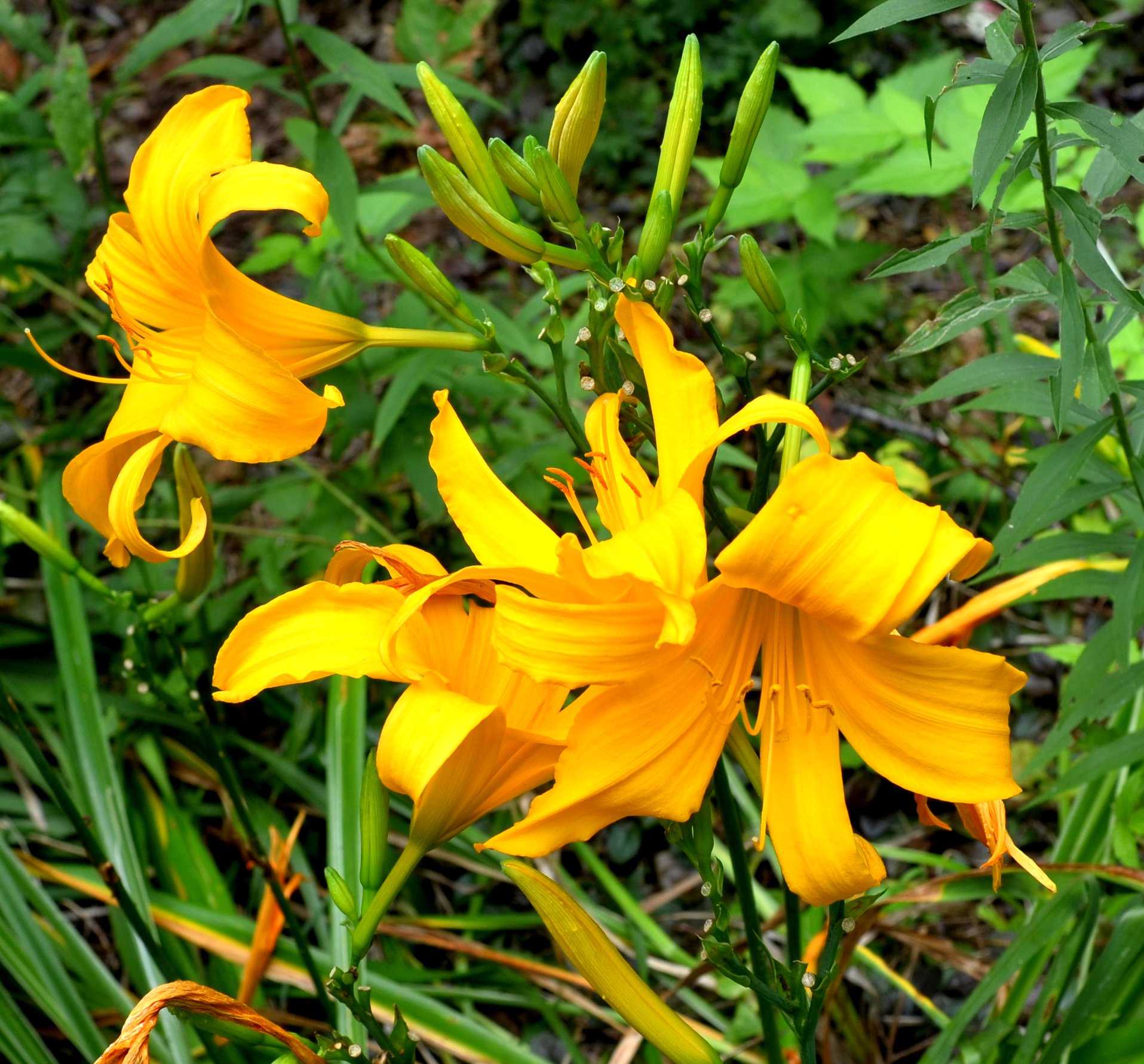
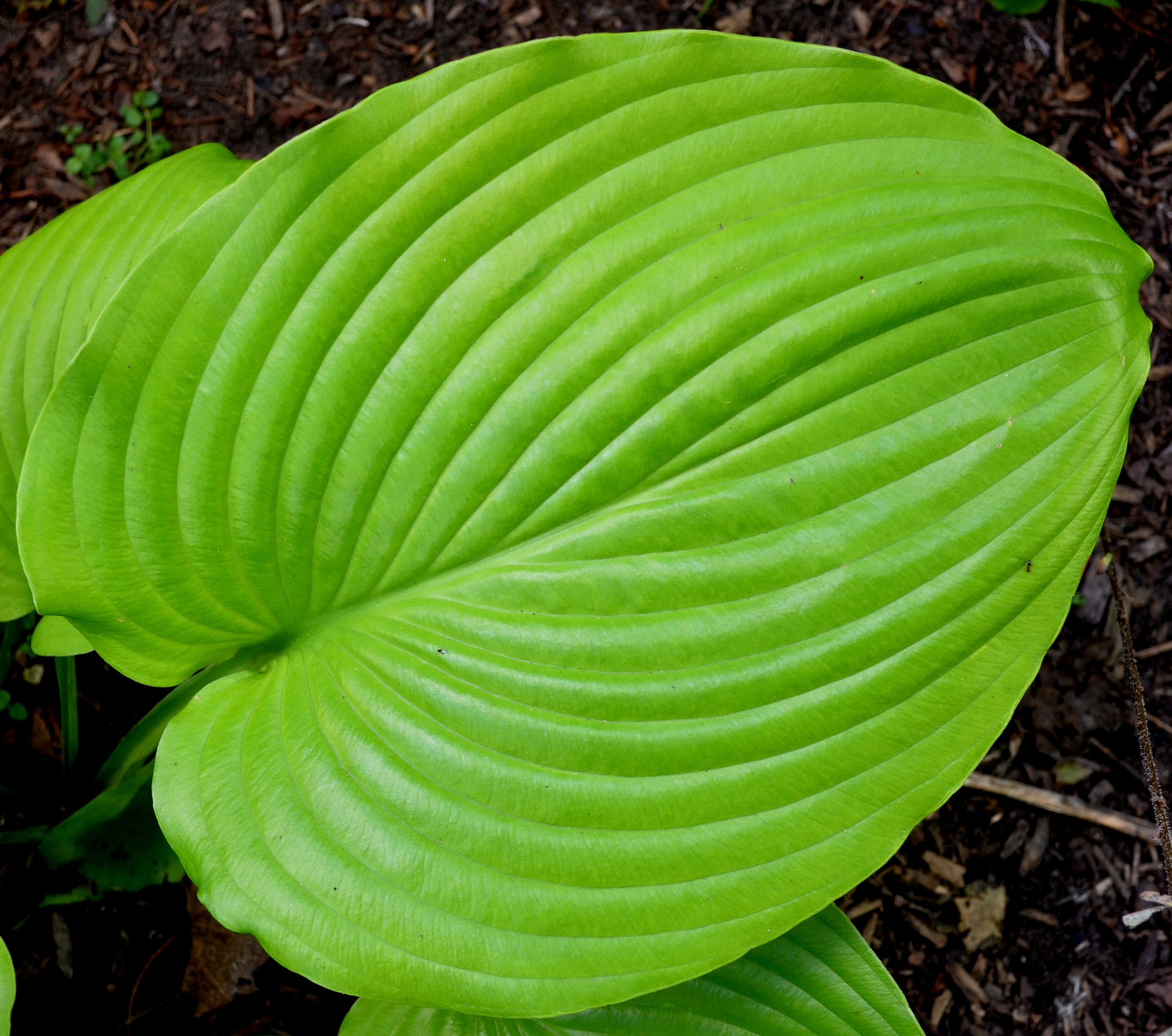
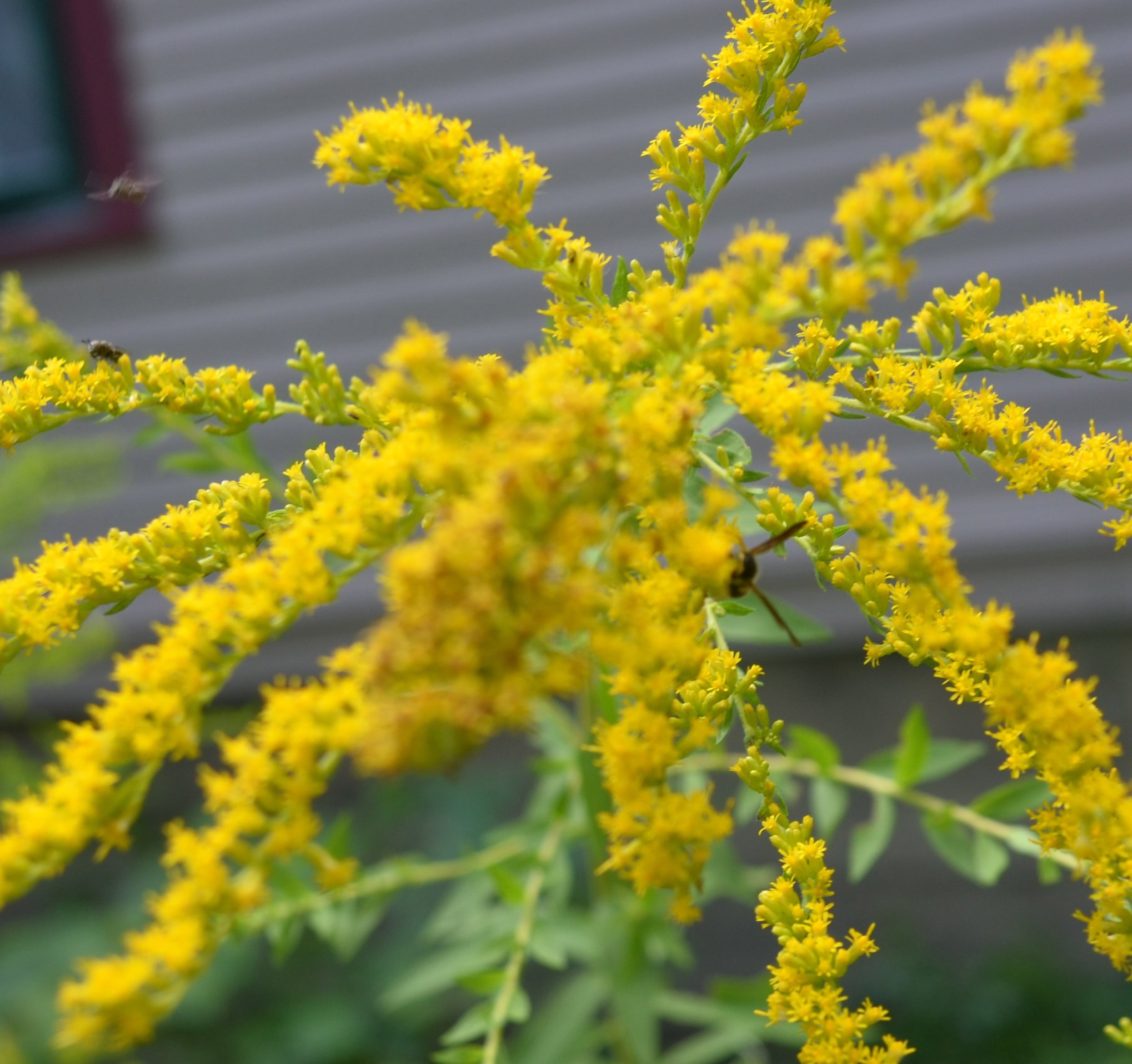
It's cool! The air conditioning is turned off for the time being and big window fans are buzzing as they pull in the cool evening air. The August Orange daylily is still going. That makes over a month of those glorious golden lilies. The hostas were wonderful this summer. The fragrant one is still blooming and although the flowers of Sun and Substance are going past, its shape is so mathematically interesting. But best of all, the Goldenrod is now opening up in several places in the yard.
Remember that there is information in the name of the file for each image. You can see it by mousing over the image - look at the lower left of the screen.
I would try clicking on the image. If the little "+" sign appears, it means you can enlarge again. Whilet is in "+" mode, click on something you want to see more clearly and it will zoom to that section. Then the info is displayed in the address line above. If the image has been cropped
so that clicking on it doesn't result in a larger picture, you can always hit control-plus to increase the size of the image.
As usual, the ants - small, medium and humongous - are visible everywhere if you just look downward onto a suitable plant, like a trumpetvine trumpet, which always has its share of ants and wasps. I wonder who nibbled around the base of the other bud. This little bumblebee is visiting the Japanese anemones, and the Halictus rubicundus bee always seems to have its nose in a flower, especially now the goldenrod's still-opening blossoms.
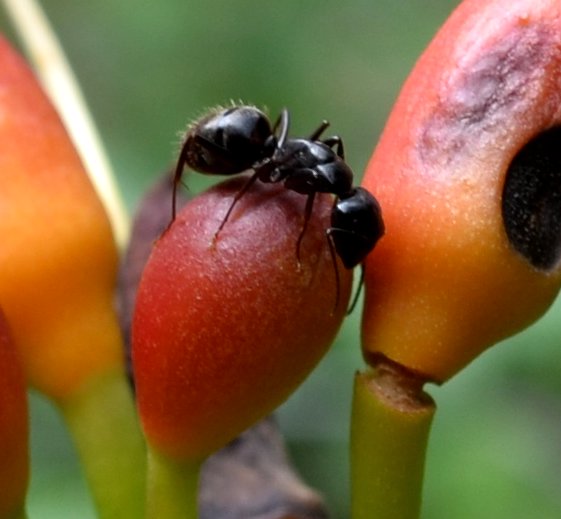
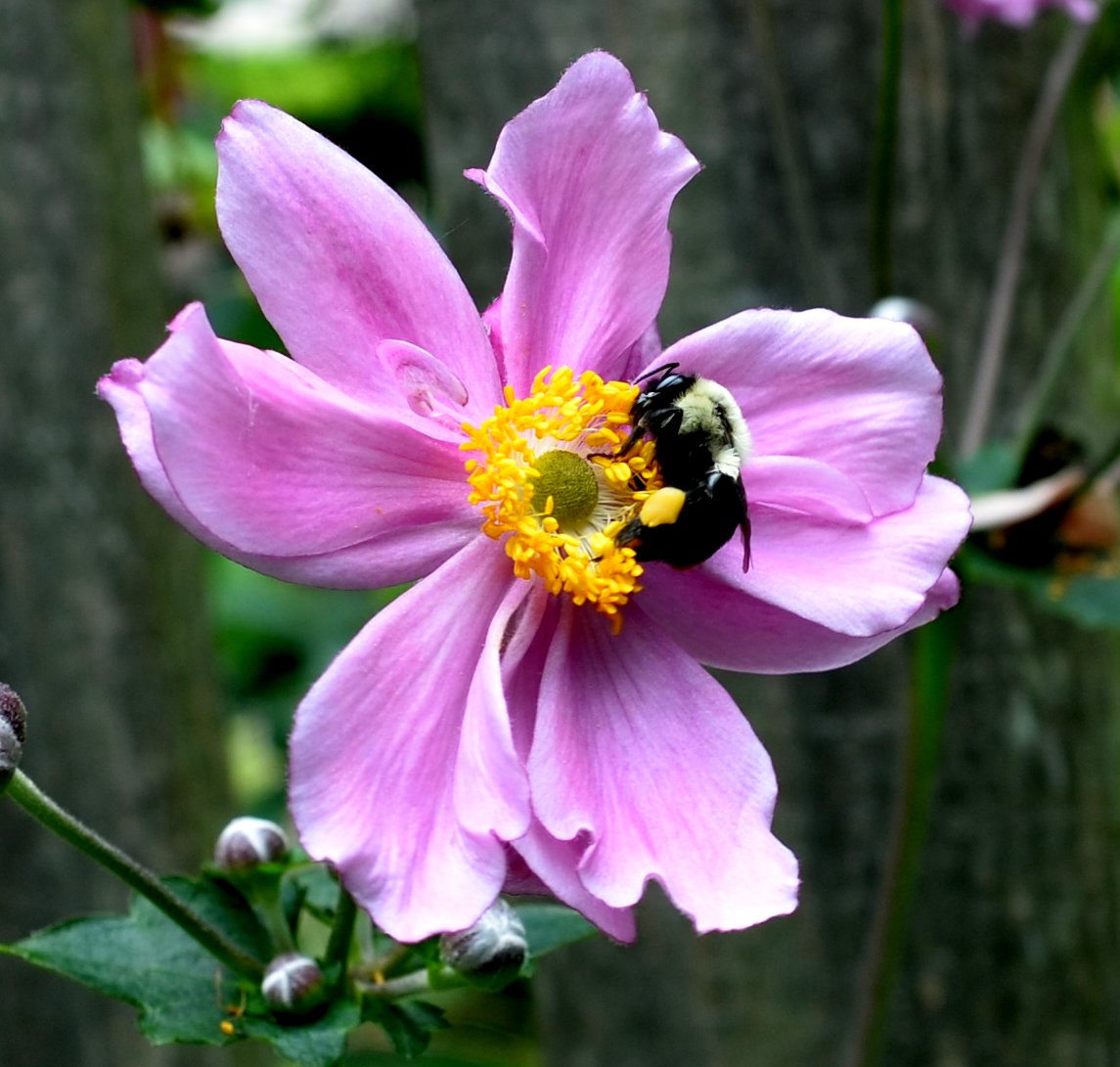
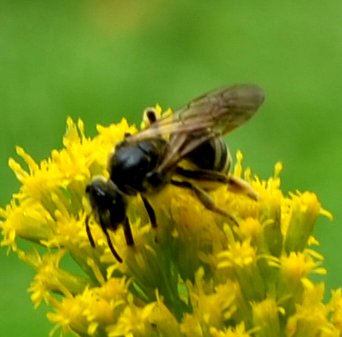
This (one of the last) trumpetvine blossom is being invaded by a honeybee. This tiny green sweat (how attractive!) bee is really leaning into those freshly opened goldenrod flowers. And this mystery bee or fly is doing its part in pollinating the world.
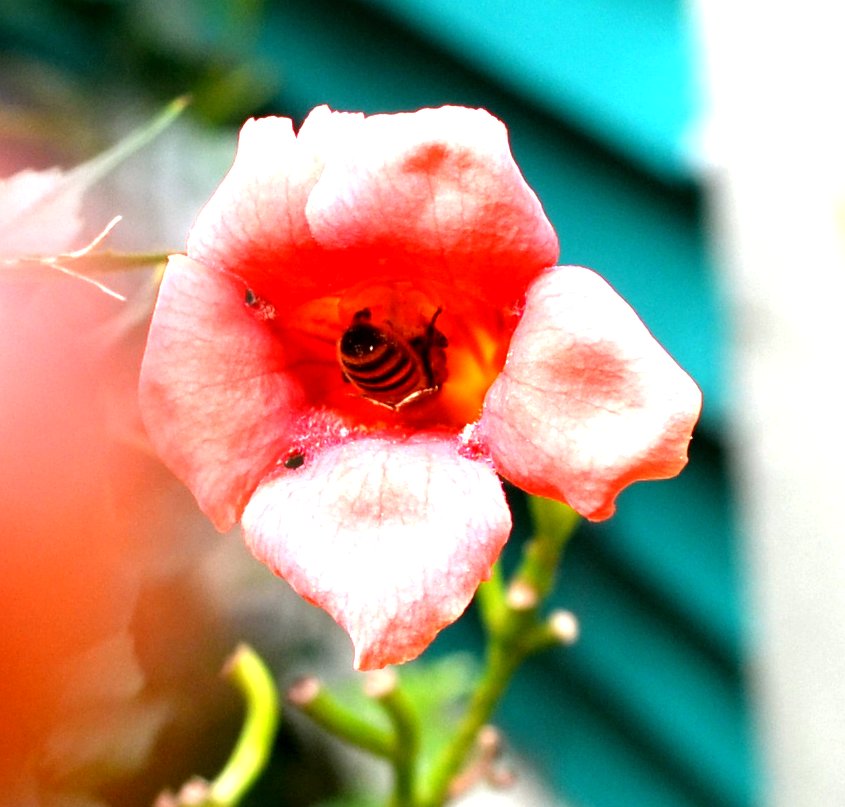
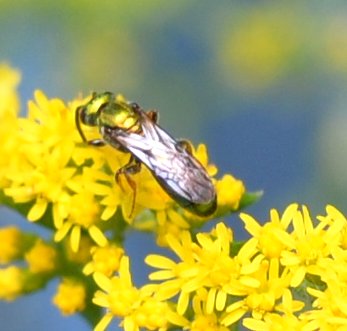
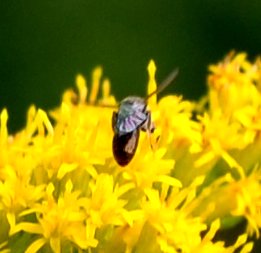
When they hear the call of the goldenrod, the Locust Borer Beetle must answer. This one has been holding state on the goldenrod (at the far back of the garden strip to the north of the house) for several days now. The Goldenrod Soldier Beetle also answered the call. As for the Sexton Beetle, I found it dead on the kitchen floor. It must have come in somehow, not knowing that there are two ferocious felines just aching to toss a beetle around. Poor thing!
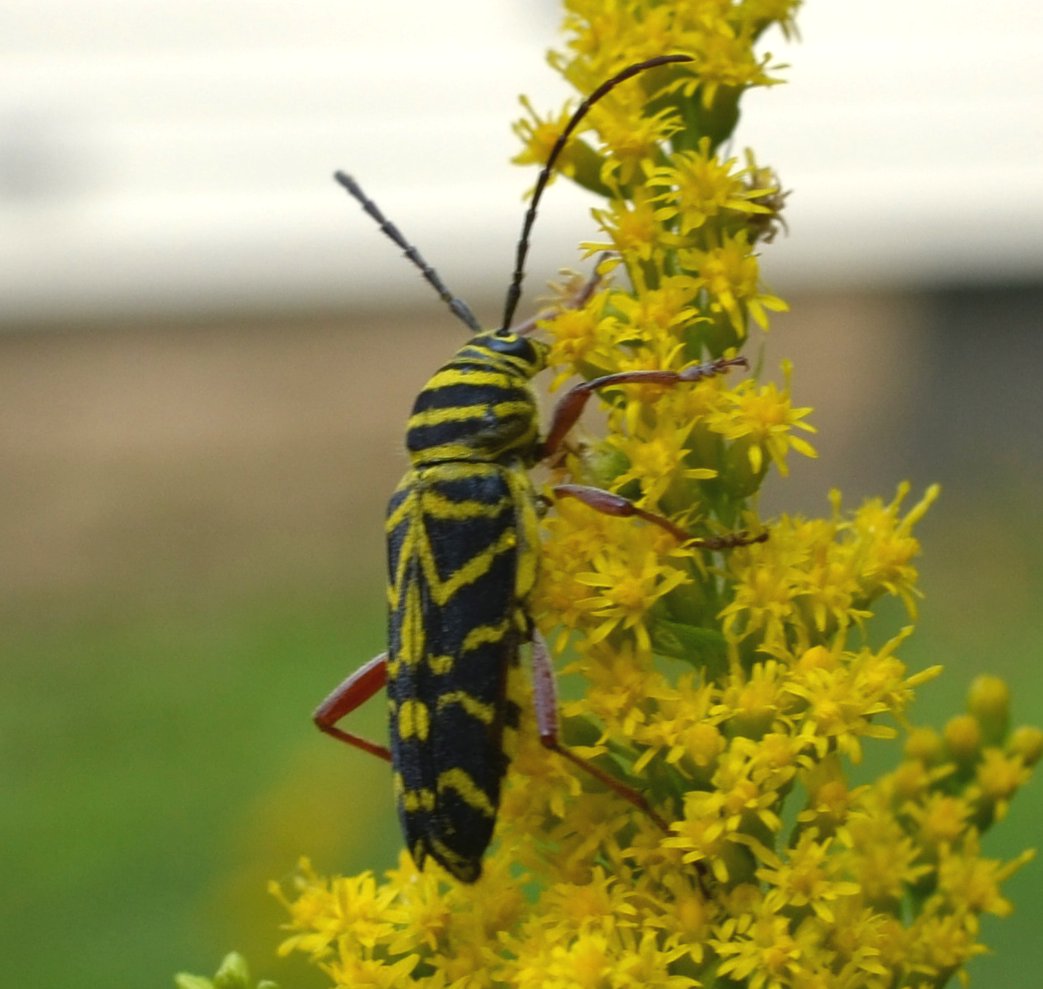
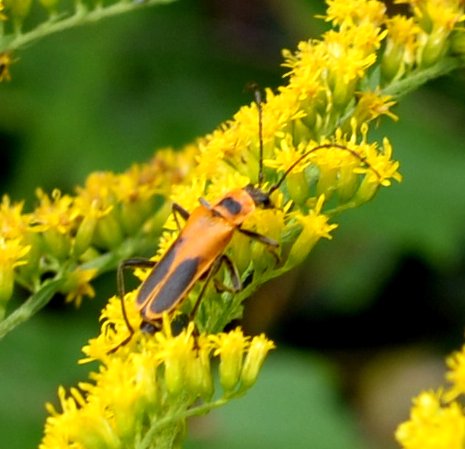
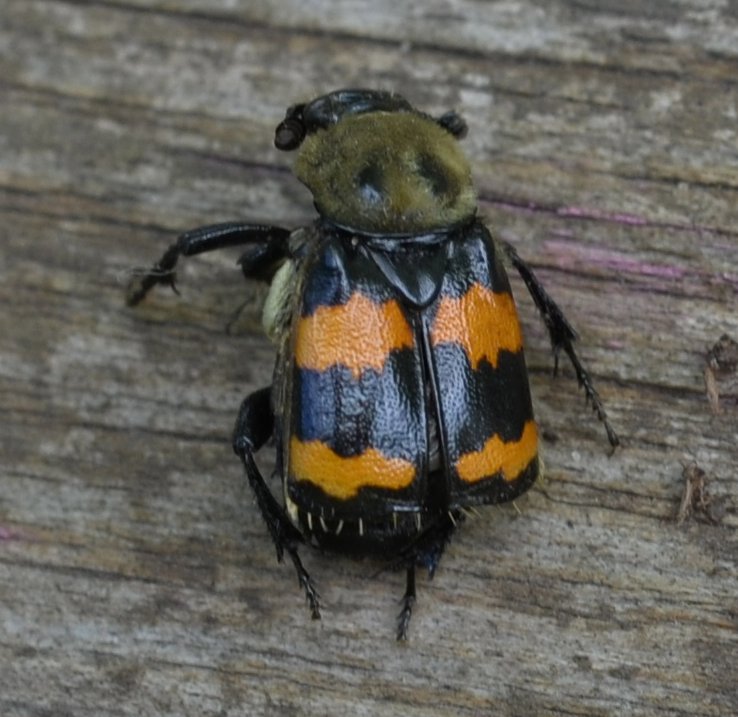
The assassin bug nymphs that were so slight the last week or two are fleshing out nicely and even hauling in some large bits of prey. Number two seems to have eaten something dark that shows through its abdomen. The third one has already brought down an animal about twice its size.
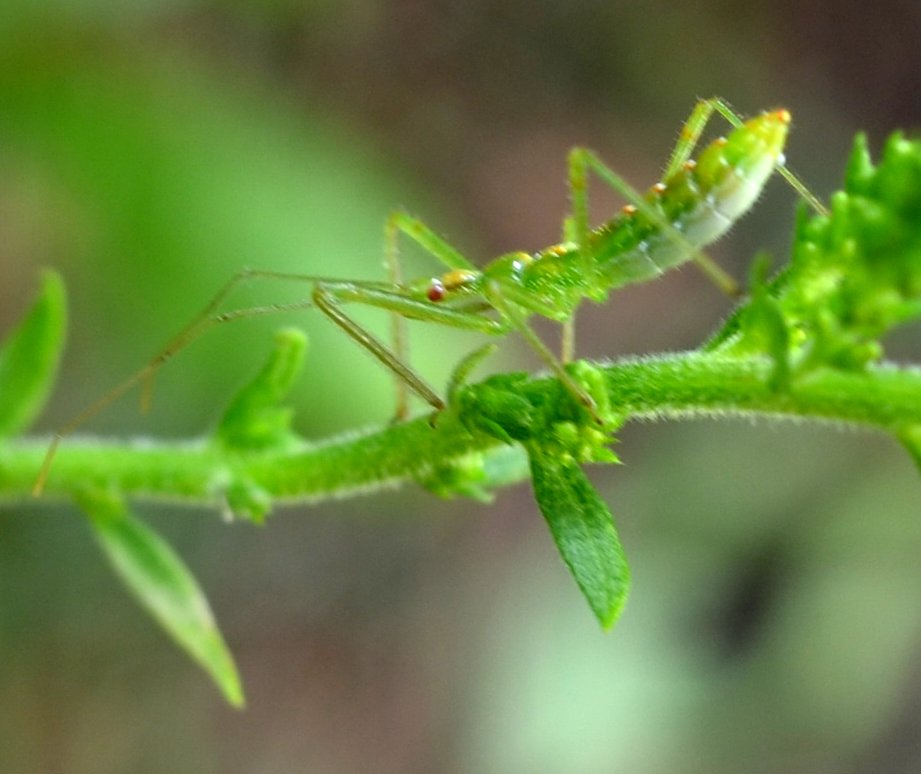
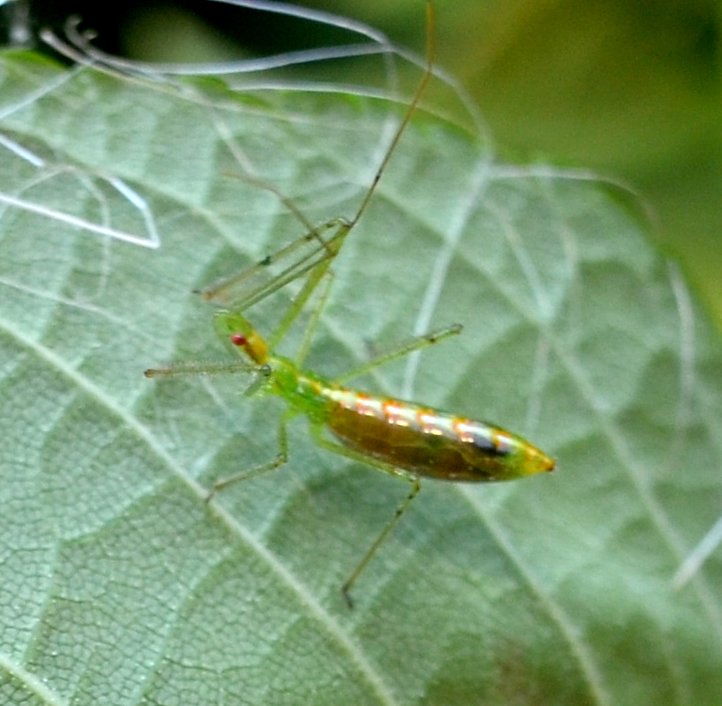
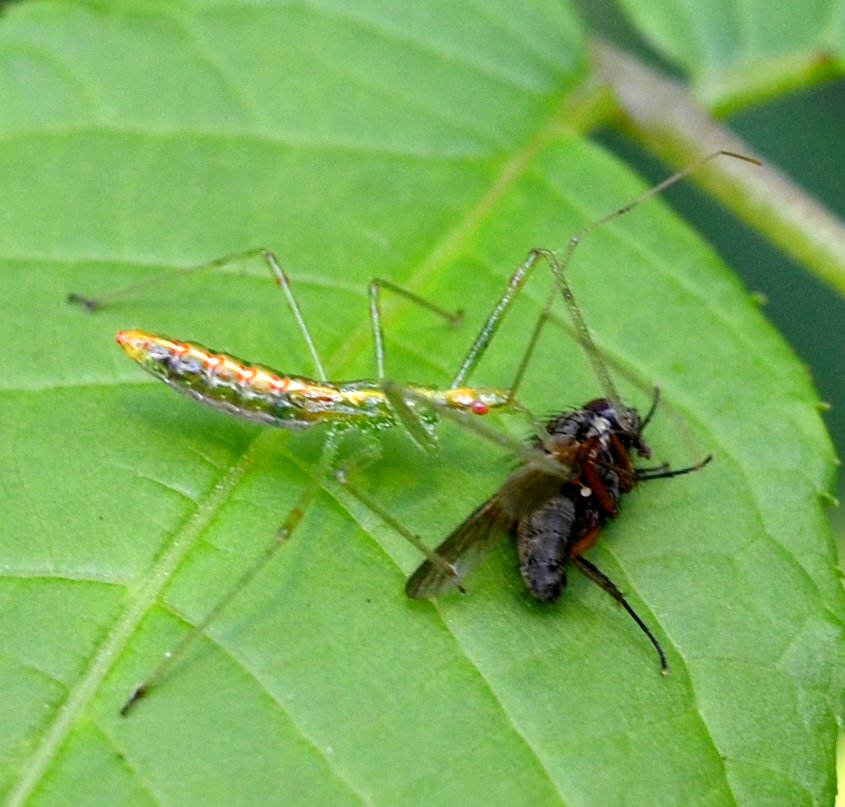
The leafhoppers, while somewhat rarer than they were a couple of weeks ago, are still pretty. This little one with its shades of pinkish brown, seems to glow; This one that's white except for its pinkish eyes likewise. Actually, these first two are Planthoppers! The yellow-and-white one is new to me. It COULD be a leafhopper though.
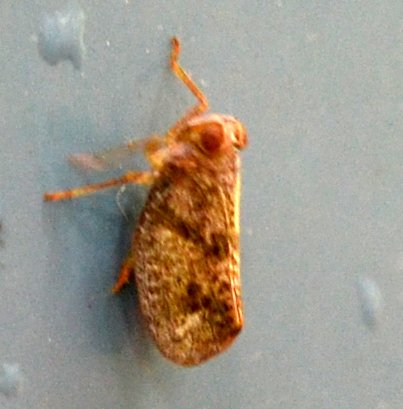
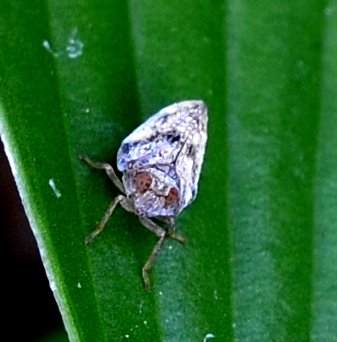
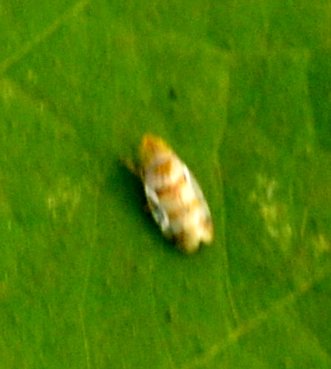
I love these shades of pink and orange. Number 1 looks like one of those Leafhoppers that are very hard to ID to species. Pop quiz: what is this brown and olive hued leafhopper? We have seen it or its nymphs almost every week for a long time. Right, it's the one whose nymph seemed to sit back on its hind legs with its tail turned up. Its name is Coelidia olitoria. The more I look at this bluish grey one, the more it seems to be a different color applied to the olive and brown one. What do you bet? I bet this is a leafhopper with a varied palette of color schemes.
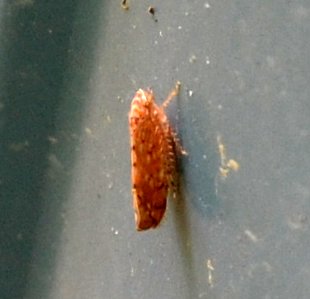
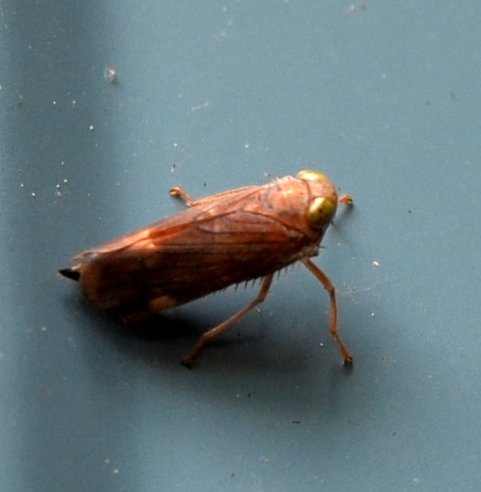
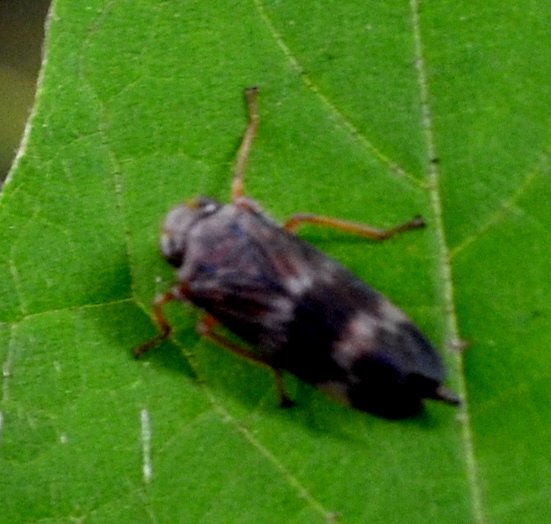
Here's that guinea-pig mimic, the Alder Spittlebug. Have you caught on yet that the black variant is the male and the brown the female. I've seen a picture of the mating, with the black one and the brown one tail to tail! AND the smaller one is the blacker one. Finally the buffalo treehoppers are out again. Note: this picture will be taken in September 2019. :-)
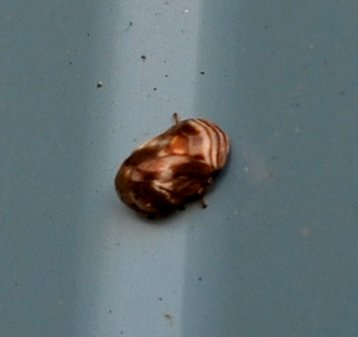
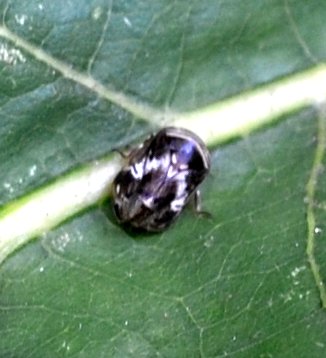
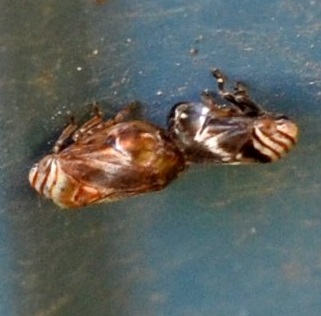
Here are a few one-offs. This may be a sign that cicada season is over. This one was lying on the sidewalk a couple of days ago. And the screaming from the trees has been easing off since the weather is cooler. Here's a centipede that was on the back of the shop. And here's the only dragonfly I saw this week. Do you recognize the markings that show it is a female? There were a couple of tiny damselflies on the pond, maybe laying eggs again, but too far away.
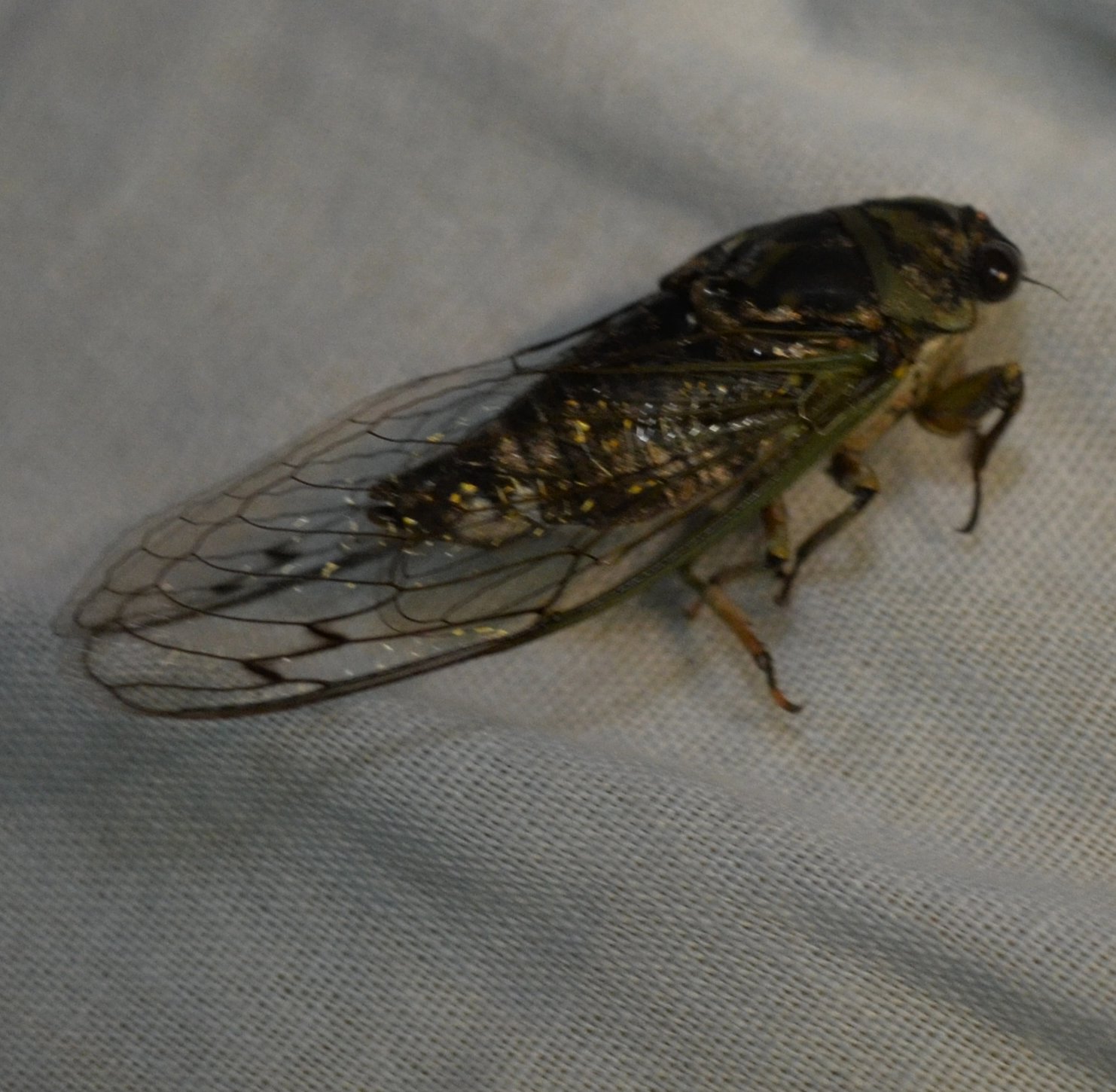
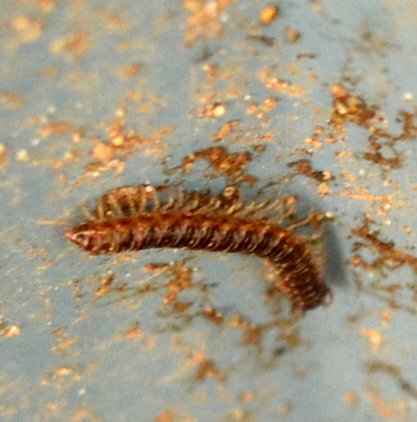
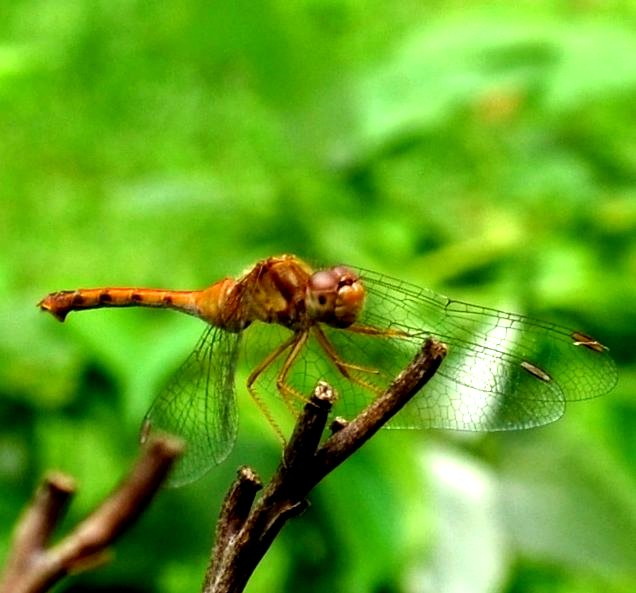
Funny that at this place in the alphabet, we have such a number of onesies. First we have a European earwig. I asked a person who specializes in earwigs and a couple of other things, can you tell me something to tell the readers of this blog so that they won't say "Ick", which is almost the universal reaction. He said to tell you that the earwig is one of the few insects (leaving out the hymenopterans - bees, wasps, ants) that takes a very maternal interest in her young, cleaning them often to make sure they are free of bacteria and fungi. I've become a convert. You're next! Here are some of the fishies in their pond whose water is at this point fairly pristine. Once I figured out that the great big suet feeders for birds can be used to keep the raccoons from shredding the barley bales (used to keep down the algae), the pond has been a lot less messy. This last fellow is a beautiful elongated snail called a Glossy Pillar.
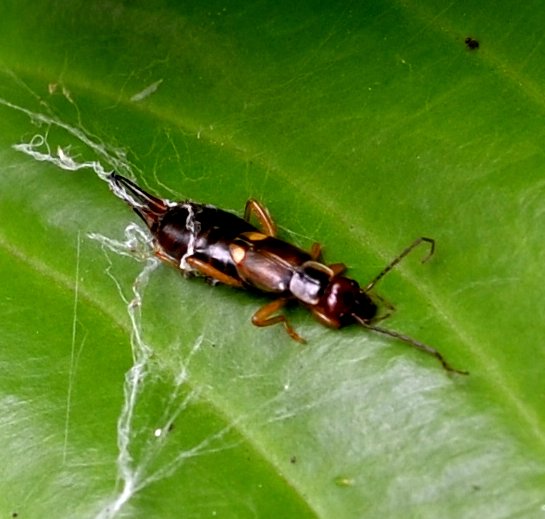
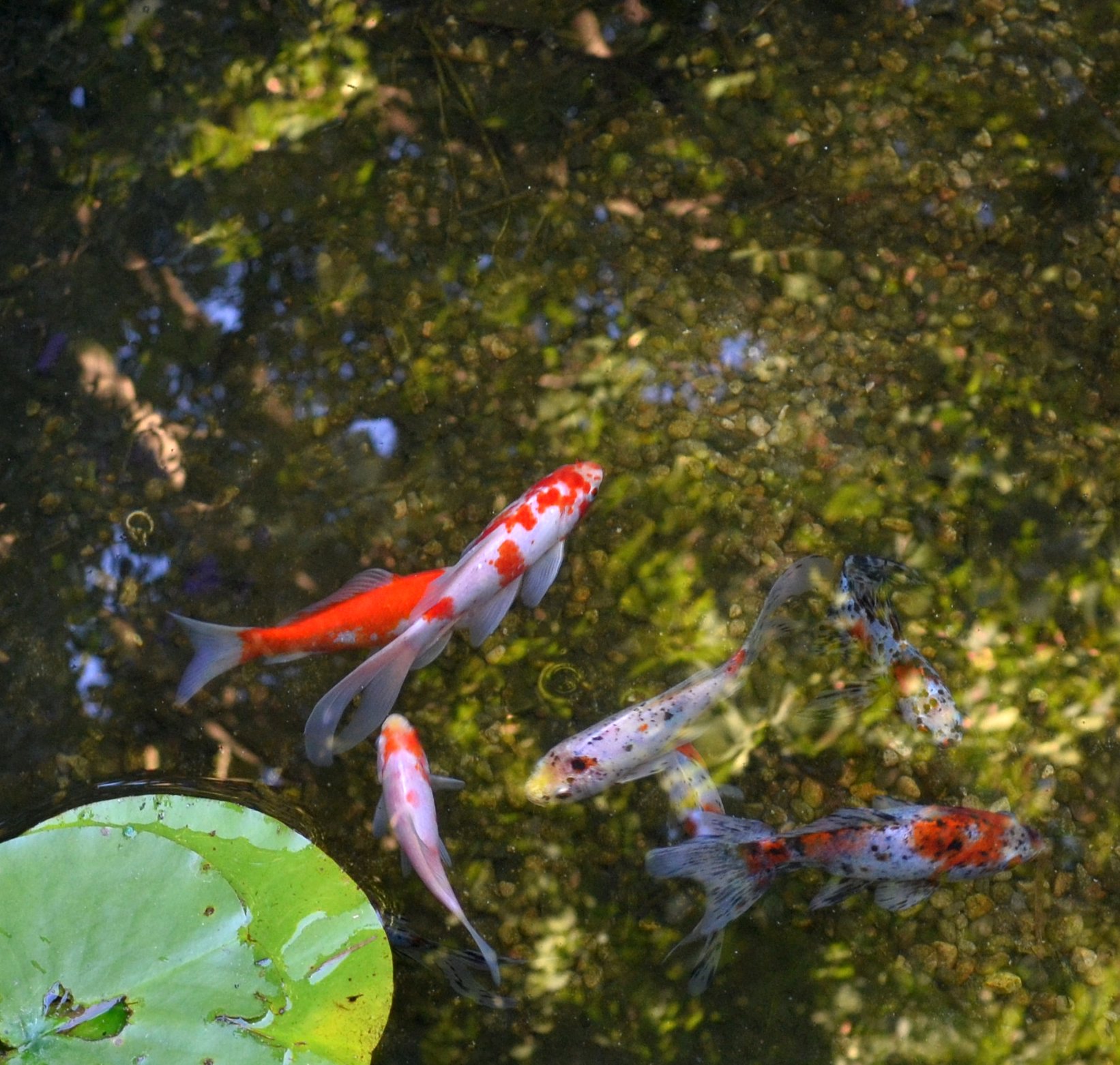
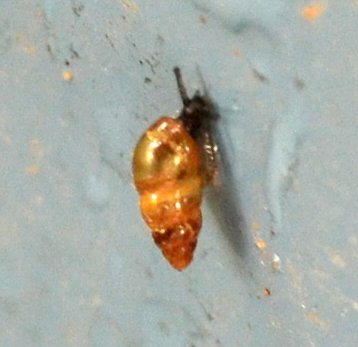
The mosquitoes have indeed been ferocious. I have just decided to bite the bullet and slather on the nasty chemicals that deter them a tiny bit. Slap the rest! Even though my working trousers have elastic hems at the bottom, one guy got to my ankle and it still itches. Neither cortisone nor benedryl cream seem to help much, the combination of the two does seem to. Anyway, that was your segue into the world of mosquitoes, the first member of the fly crew that we'll visit. Here is Ochlerotatus trivittatus, with its bold stripes of black and white. Next is Psorophora ferox, and I'll bet you can figure out what ferox means. Lastly, even though crane flies are NOT mosquitoes, I'm fitting this tiny crane fly into the list.
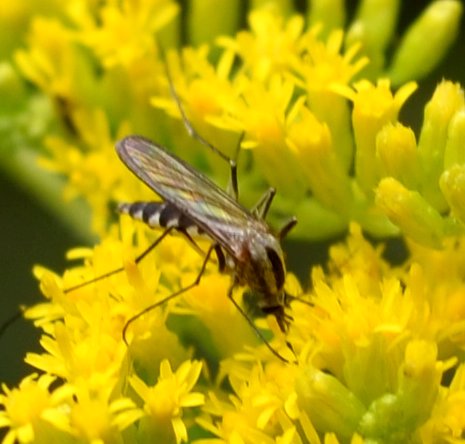
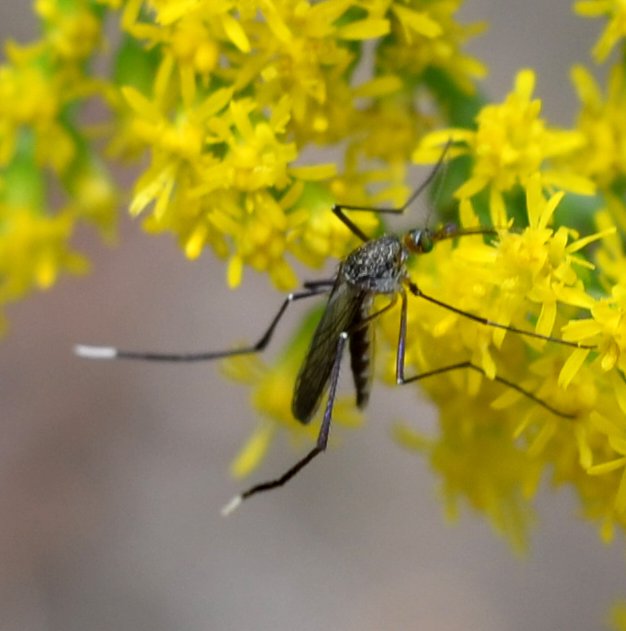
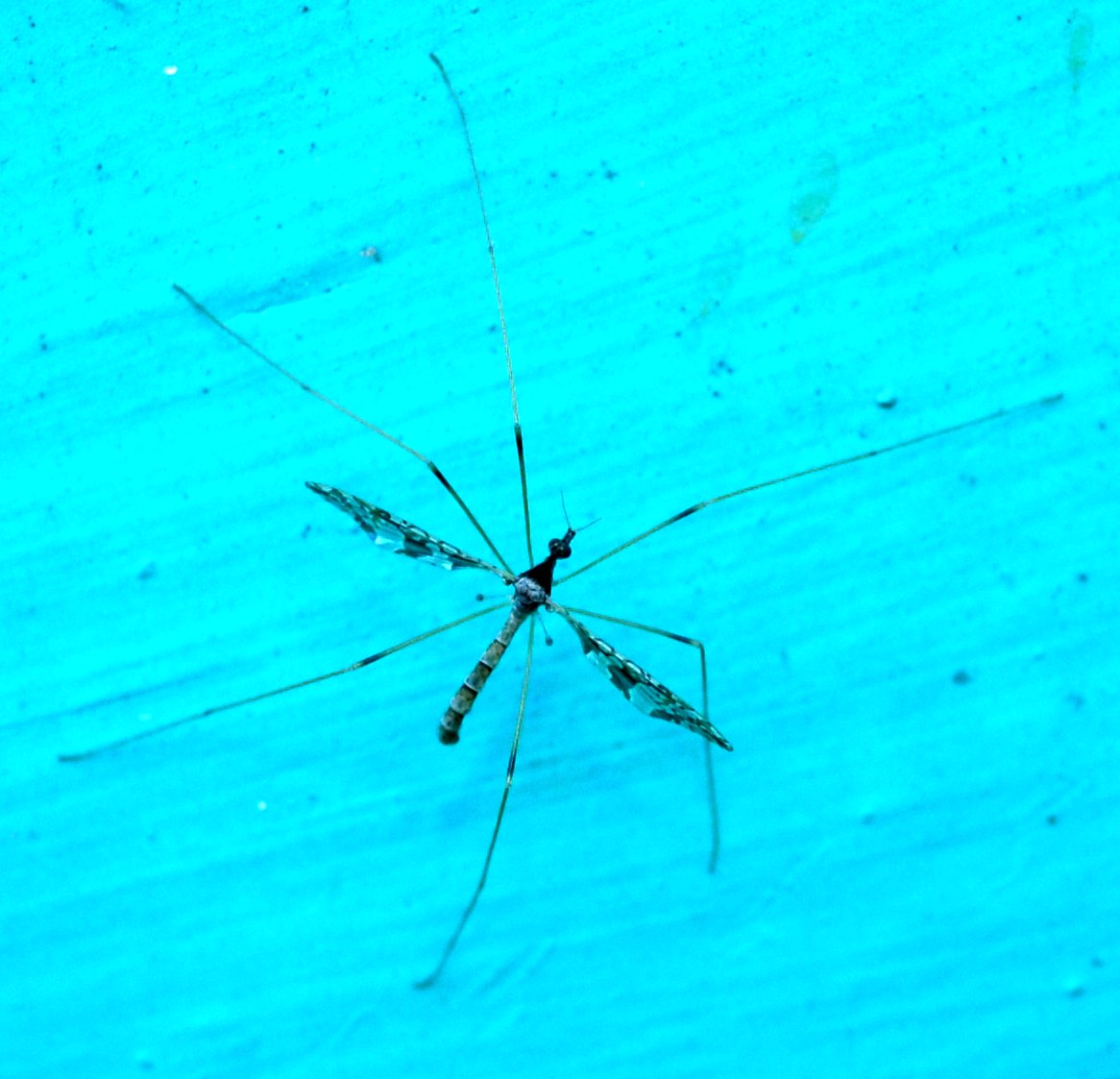
Here are a few long-legged flies. First a really gaudy one, then an actually pretty tasteful one, third - the shadow tells what the cute little fly would like to be like.
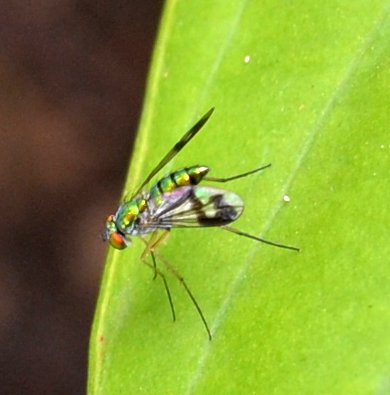
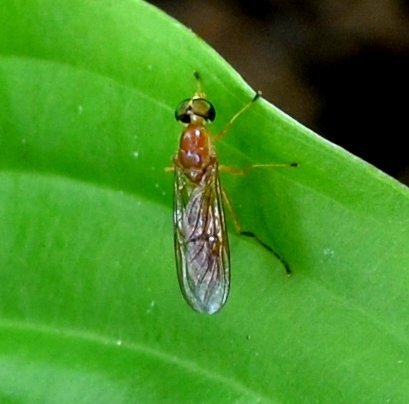
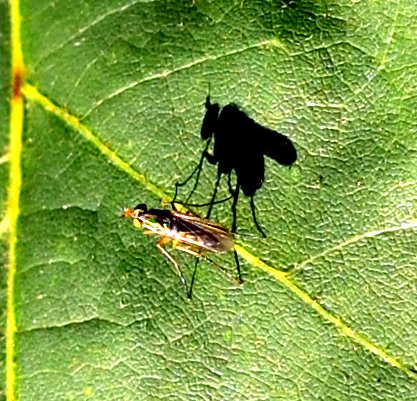
Flies are such great mimics - they can fool anyone - for a swift moment. This one (called a bee fly) is mimicking a brown fuzzy bee; this one (called a moth fly) a moth, and this one (called a horse fly) ummmm is imitating a horse? Hmmmm. Not really!
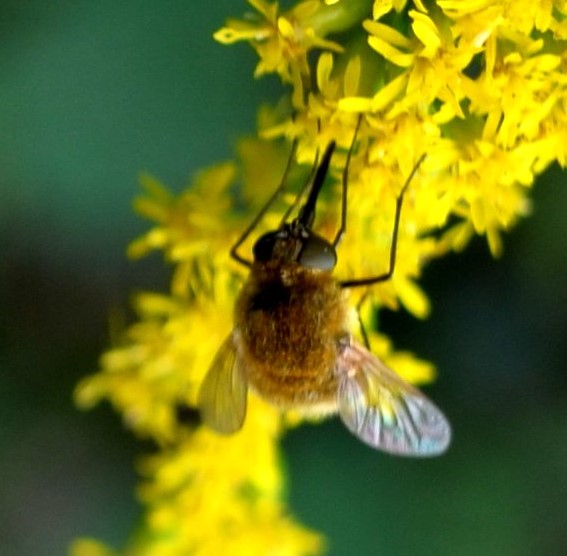
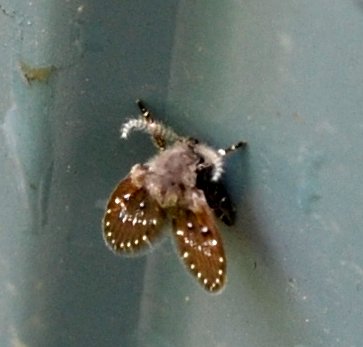
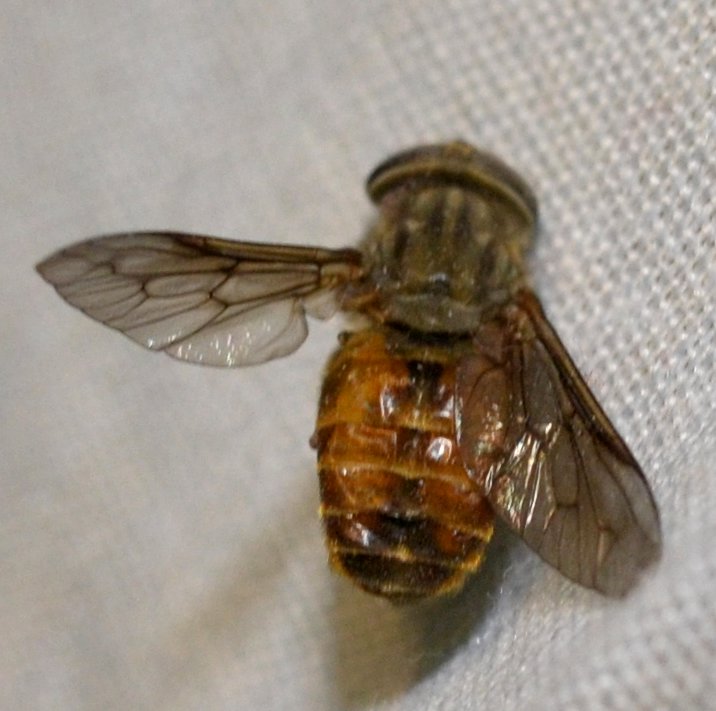
Some of the smallest treasures are flies. I was sure that this first one was a wasp. Its black head and wings contrast so nicely with its reddish-orange body. It is only about an eighth inch (about 3 mm) long and at first when you catch your first picture of it you see that it has a thin waist like a wasp. But it's a fly (a member of the Rust Fly group)! I keep trying to get a positive ID on this one, but it's hard to get someone else to agree. The next surprising fly I supposed was a tiny wasp in a goldenrod section covered with different kinds of wasps and bees. But when I saw its huge fly eyes, I could see that I had been confused by it. It was indeed a fly, Trichopoda pennipes, that is to say, hairy legs, wingy-feet. Look at the legs. You might almost think you were looking at the leg of one of those leaf-footed bugs. Now THIS is one of my very favorite flies.

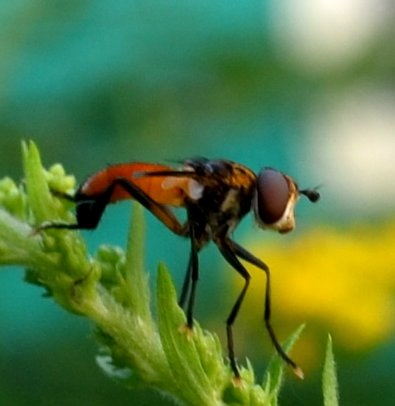

As luck would have it, the next day I saw yet another kind of wasp that again morphed before my eyes into a fly. It was clearly related to the last one but obviously a different species, Trichopoda plumipes. That is Hairy legs feathery feet. Here are two pictures of it, followed by another individual that seemed to have less red on it (but is actually the same individual). I also discovered in my bag (set of photos, not a real hunting bag) one with a red head but otherwise shaped much like the others. I think we have three different species in that genus!
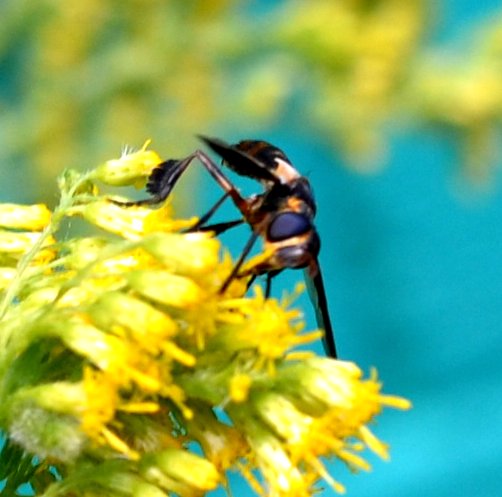
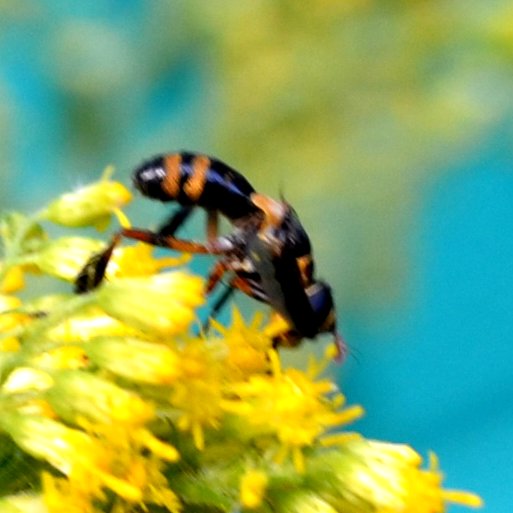
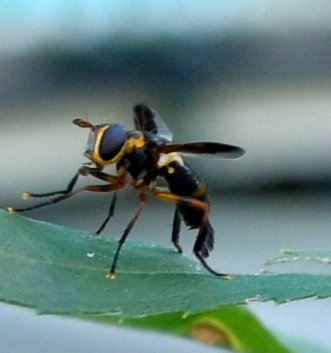
A few more flies: One of those marsh flies we've seen so often; A miniaturized fly with white (clear) wings; and a mystery fly or wasp I almost counted as one of the Trichopoda, but look- no feathery legs.
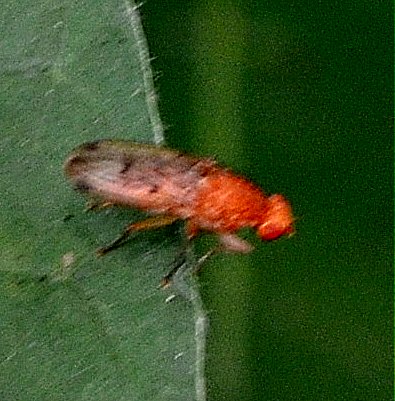
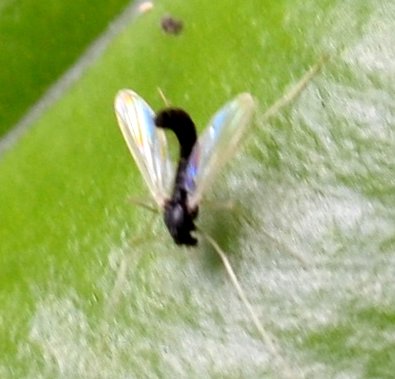

Another sign of fall: the spearmint leaves are turning many from green to pink. The pond lilies aren't slowing down though. The yellow ones are particularly hopeful when they just begin to open, but magnificent once they have opened fully. In the third image, how many fish do you see?

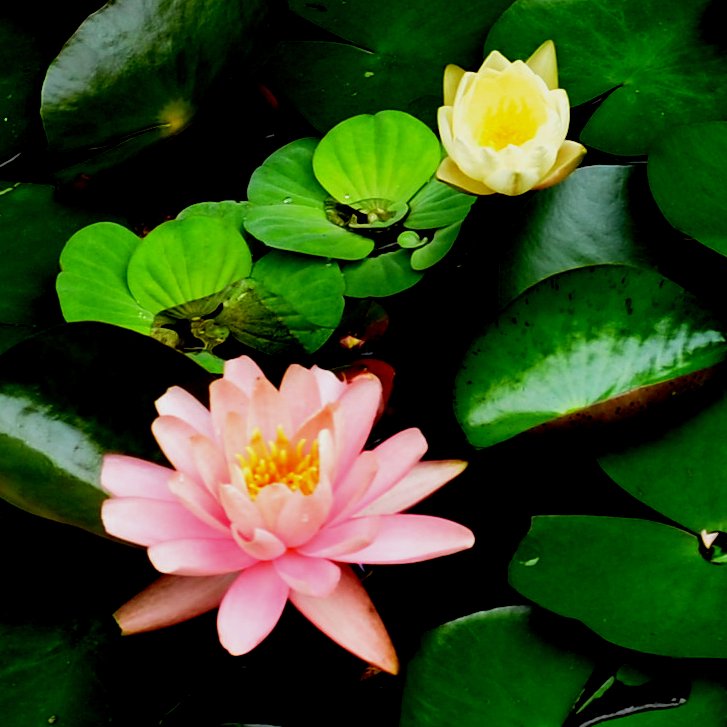
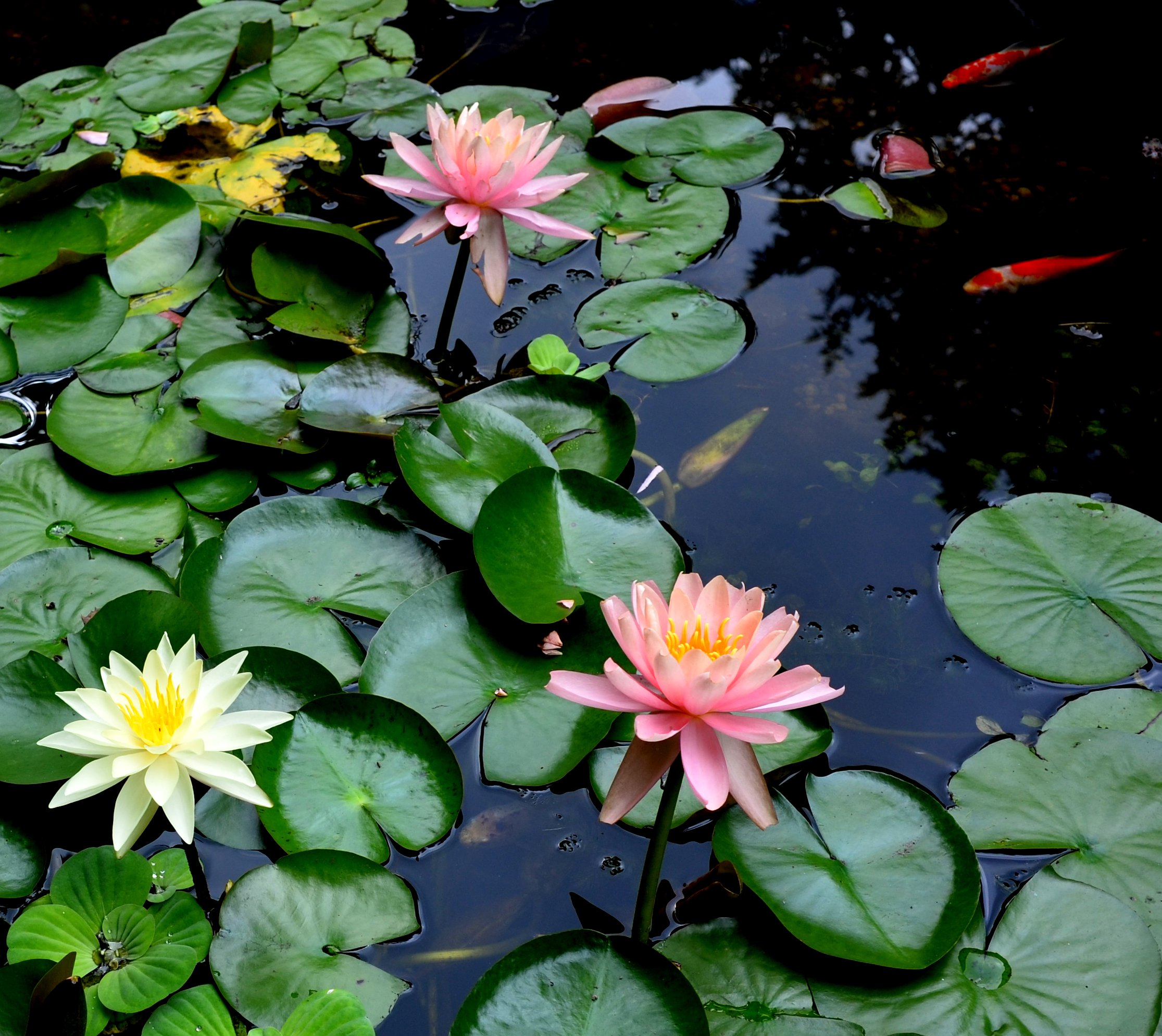
This wasn't the only harvestman I saw, but the only one I snapped on the shop siding. This longish ichneumon has been around for weeks now on the hosta. I'm not sure of the name of this last one.
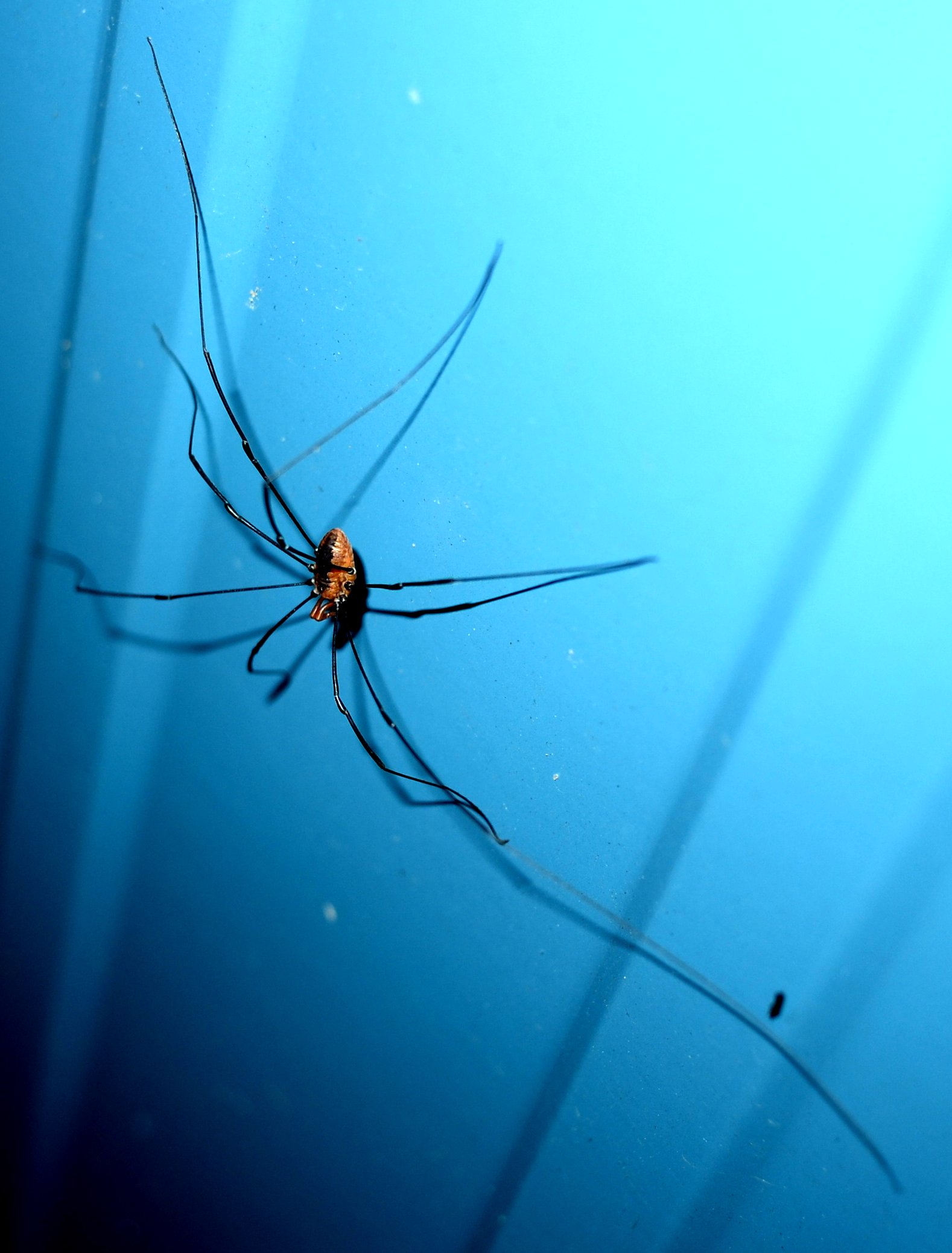
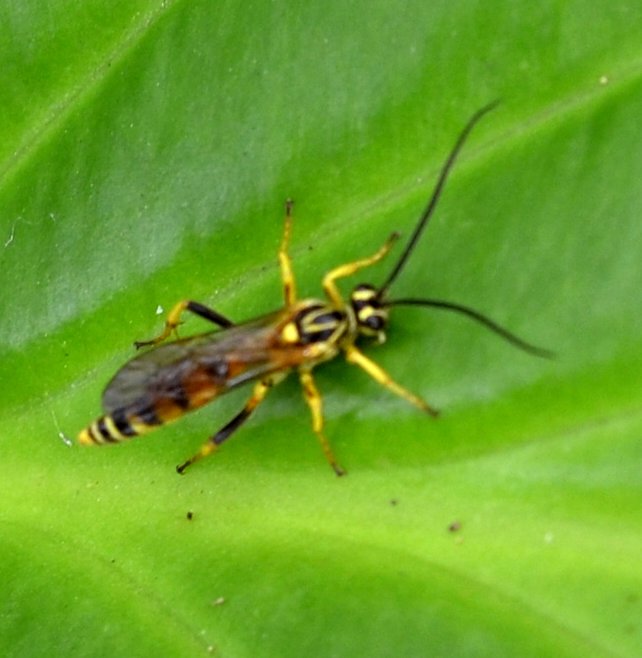
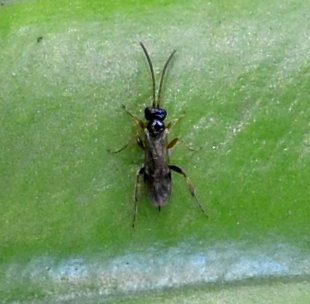
Speaking of the ichneumons, they seem to send their tiniest, most delicate ones to the goldenrod. I think this is one of the ones with a red abdomen and otherwise black pieces. The second one has a long ovipositor so it IS an ichneumon (or possibly a Braconid Wasp) and a female to boot. And now our necks snap as we turn to the moths, starting with this pretty grey and black moth on a dying thistle.
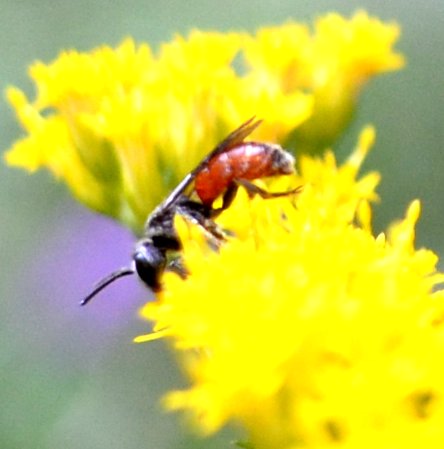
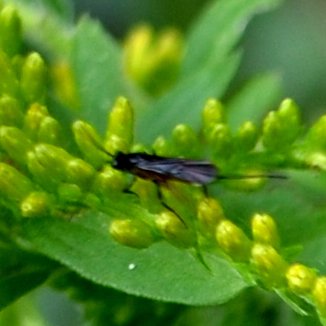
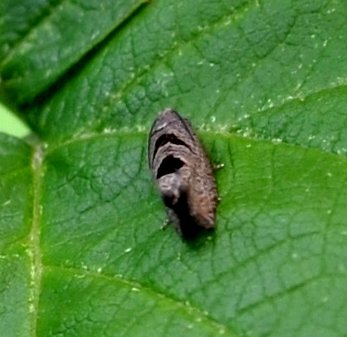
These first two are not yet identified (by me), nor is the tiny tiny one in the goldenrod above and the last, little white, one .
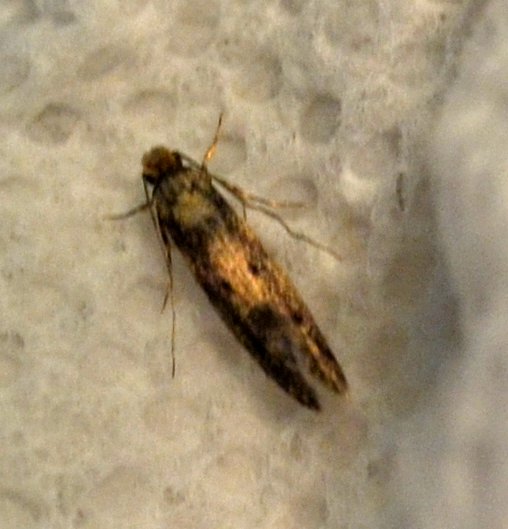
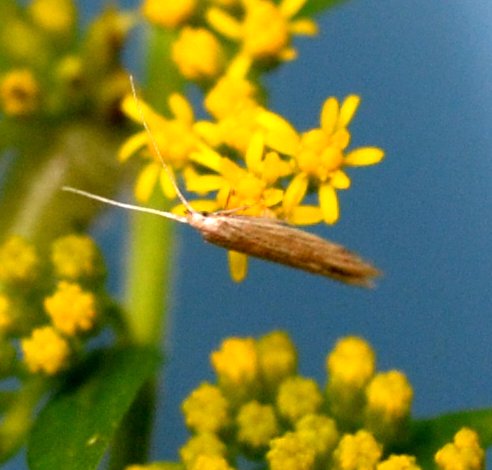
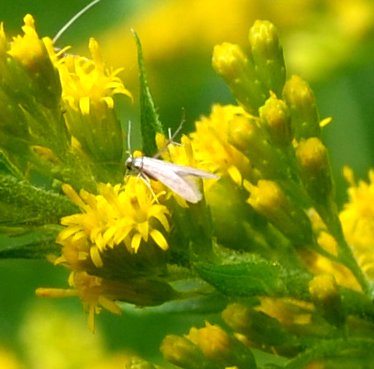
Of the seven caterpillars that I ensconced in the nightshade climbing on the side of the house, I've only seen two of them and them not for several days. Meanwhile the nightshade is largely denuded. I was finding some larger pooplets earlier in the week and so am figuring that the ones who were quite large when I got them have already pupated, and the ones I'm showing here are probably by now either lining some bird's stomach or have pupated. The hornworms don't make themselves silk cocoons, but rather drop to the ground and burrow underneath some leaf litter and simply shed their caterpillar skin and go to sleep as naked pupae.
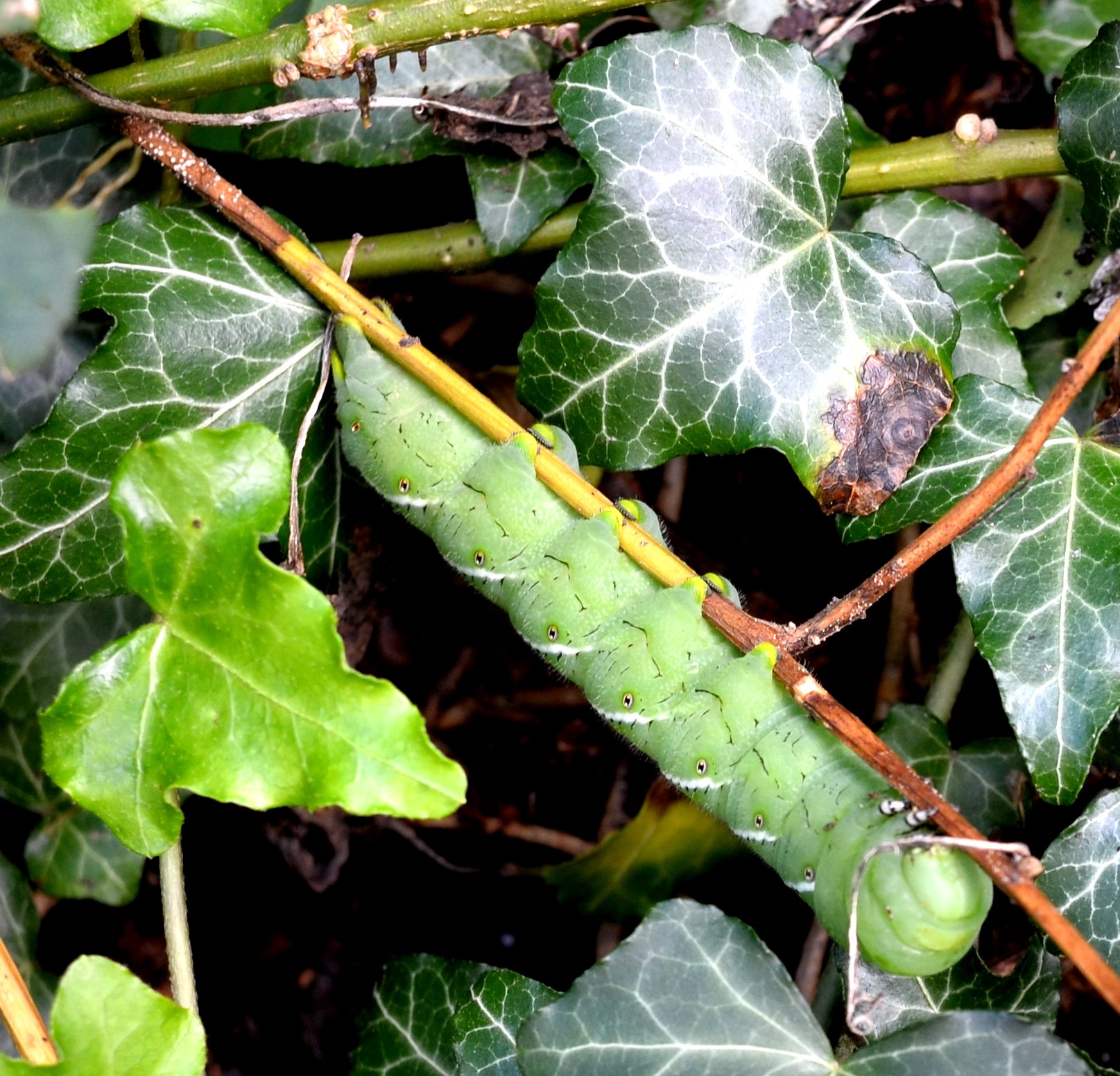
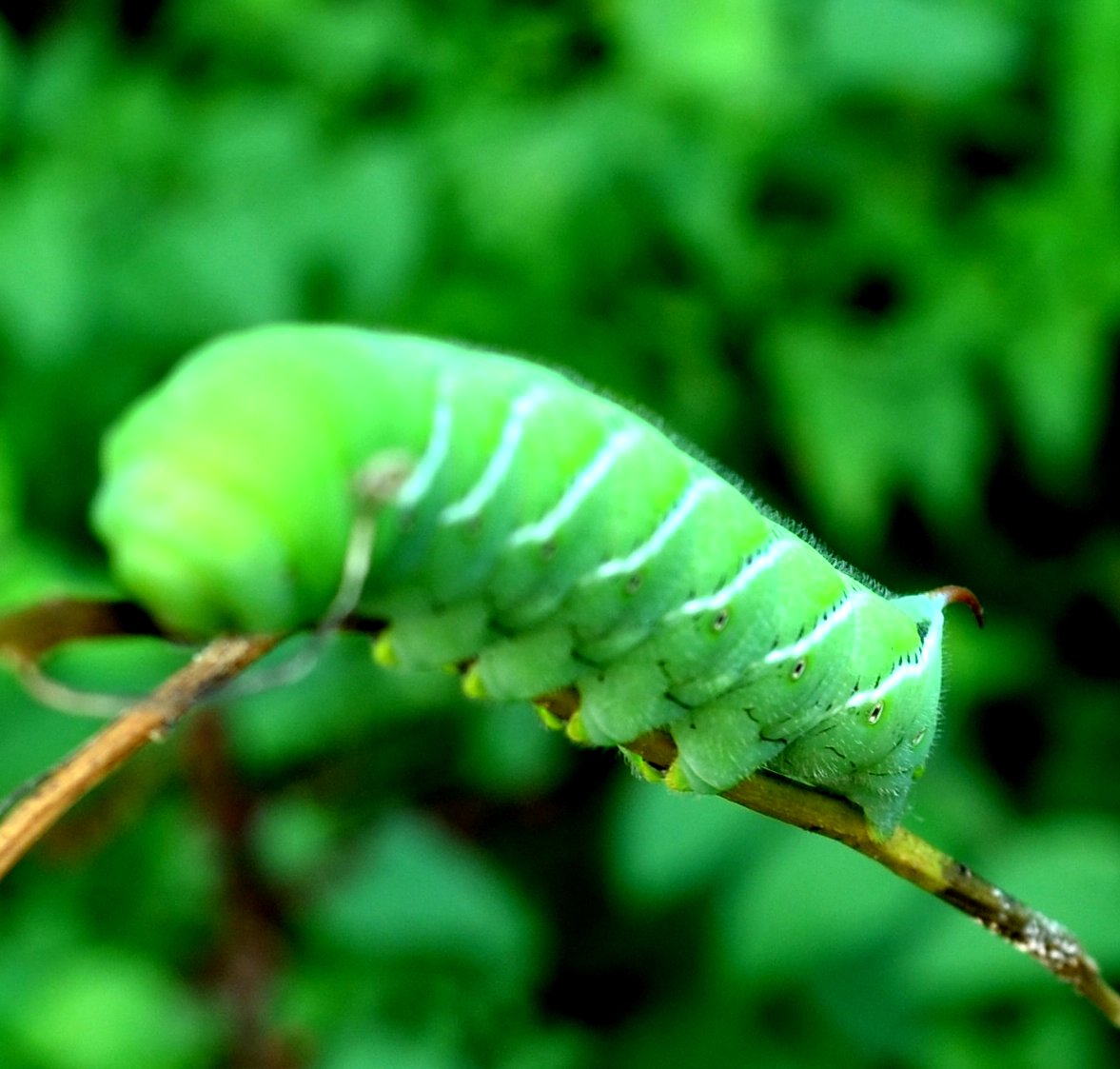
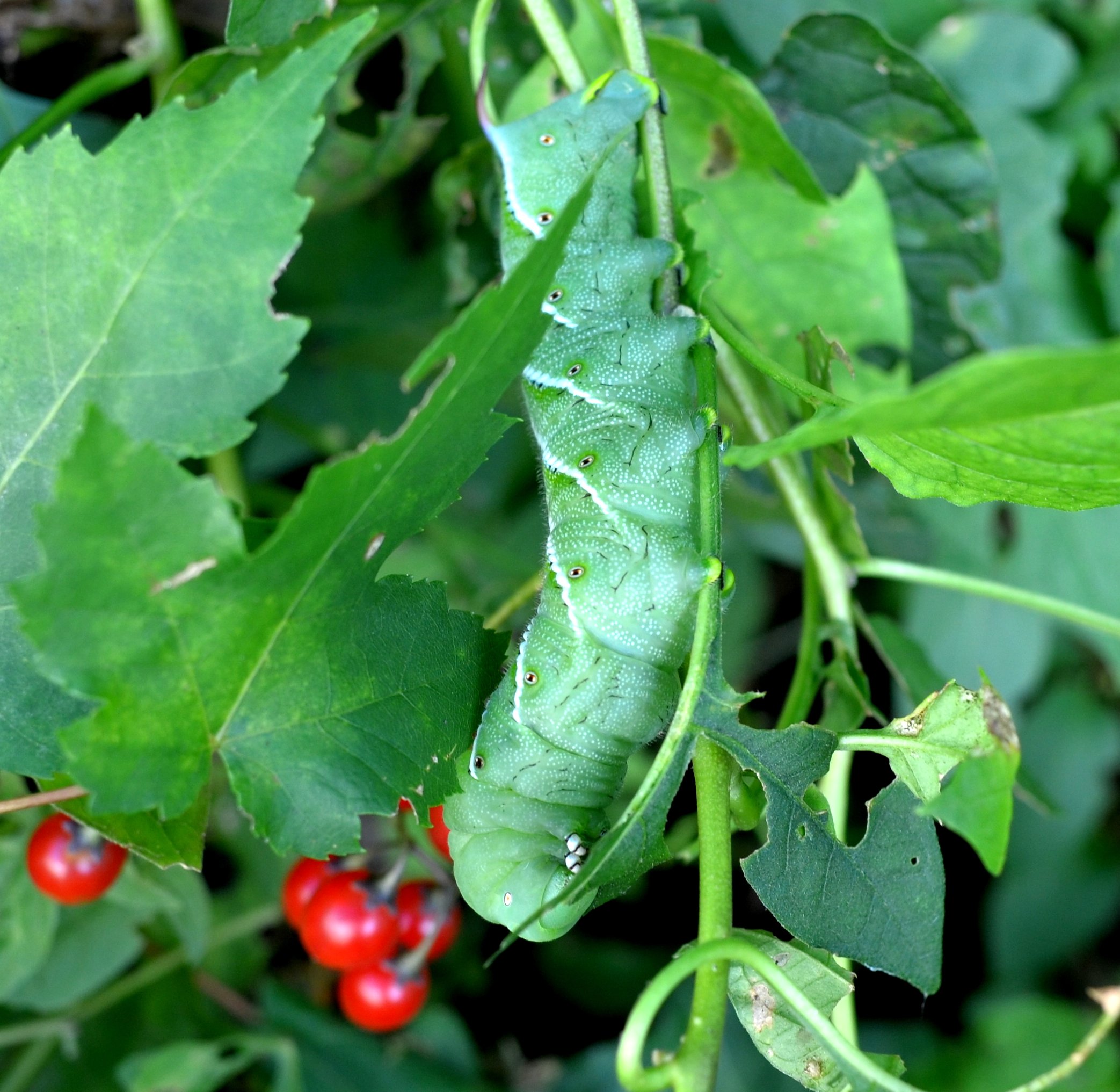
These two red mushrooms popped up through the ground just next to the shop wall. By the second day, they looked like this.
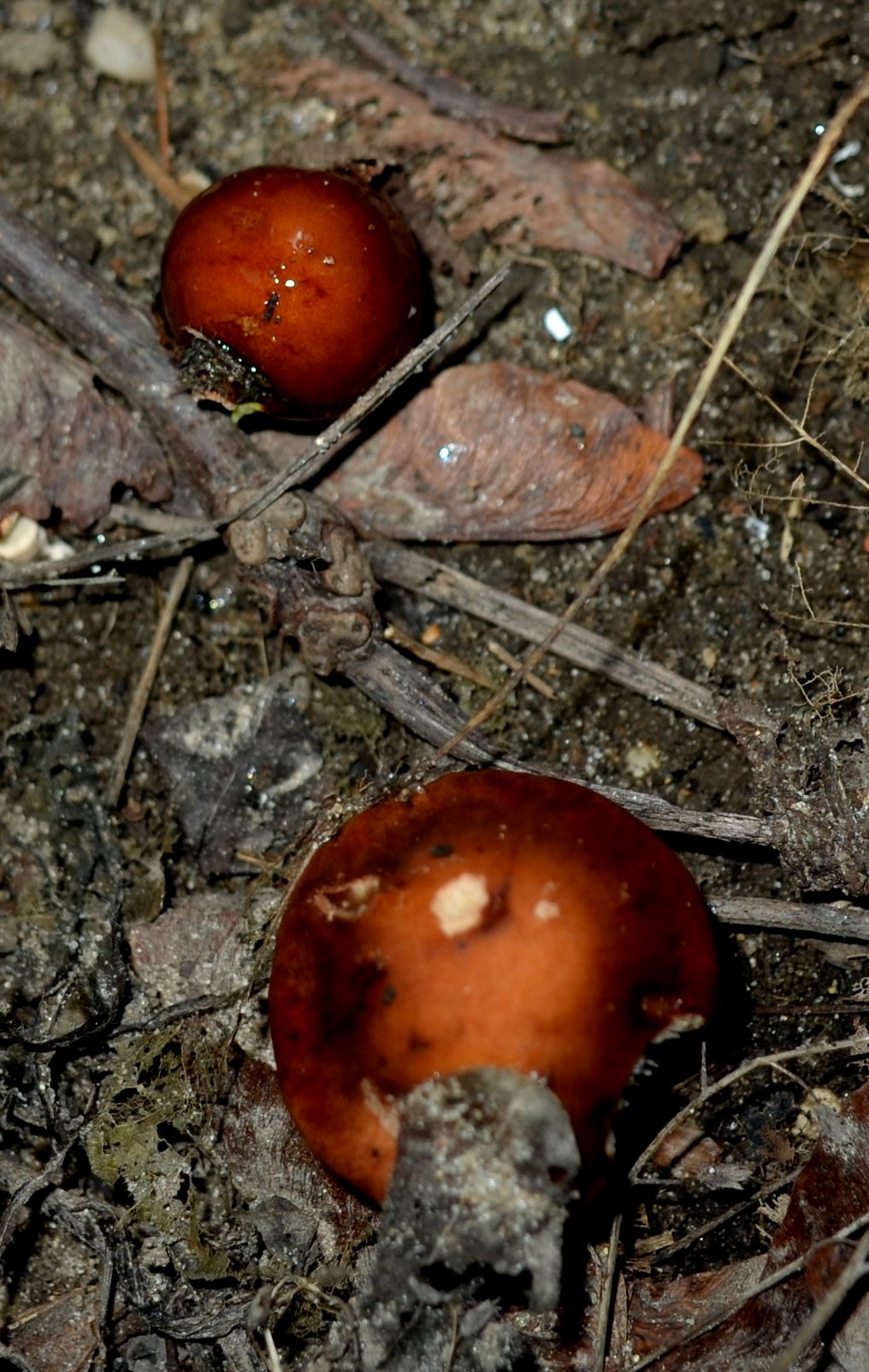
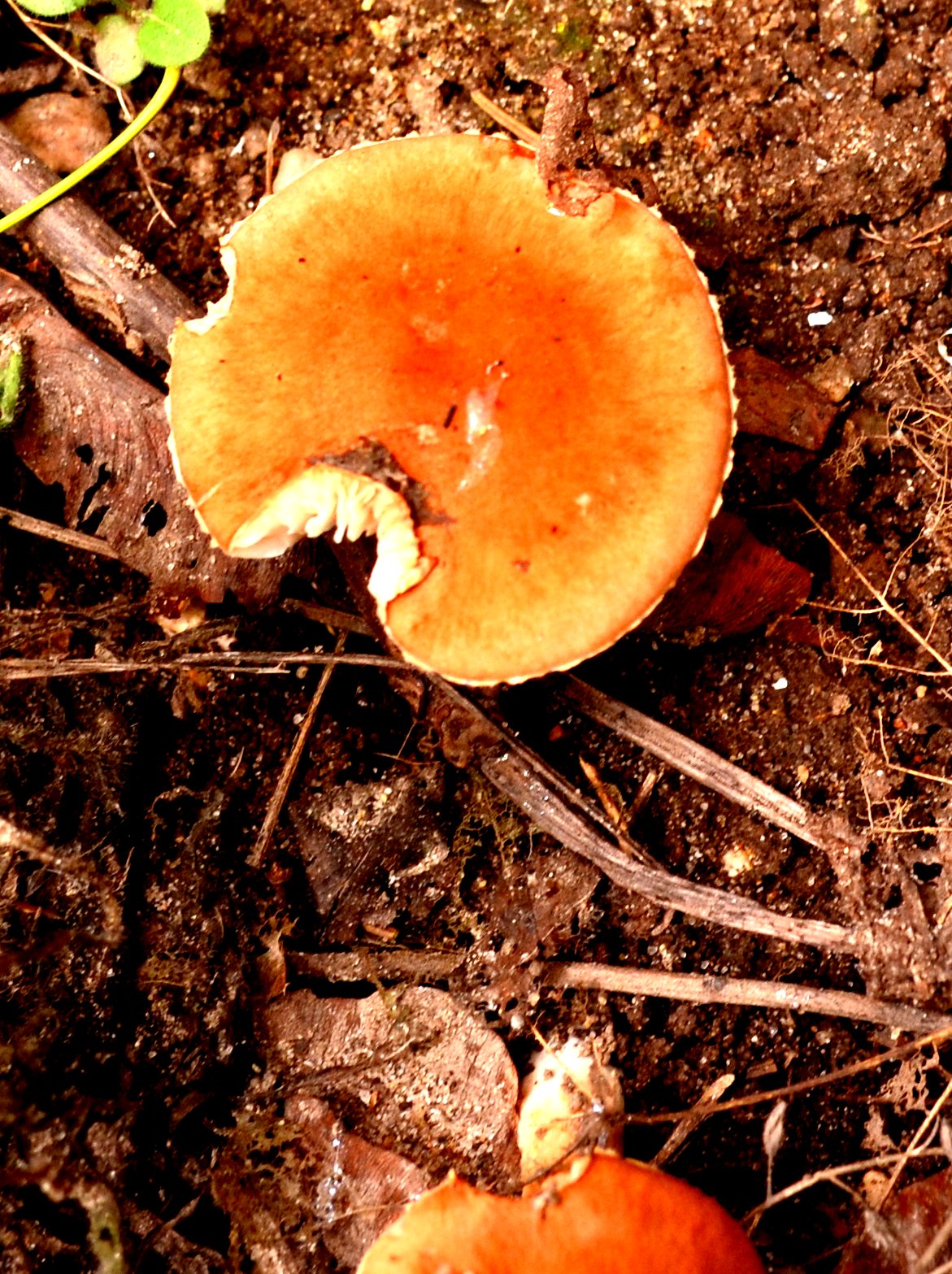
The differential grasshoppers (there are at least three or four of them) tend to perch on plants whose stems are about the color of a brown grasshopper. I'm guessing that the larger ones are females. Sexing a grasshopper is not just a question of looking for an ovipositor. The cerci at the end of the abdomen are supposed to be a sign of a male if they are big enough. The cerci are like the two prongs at the end of an earwig's abdomen.) The pointy cerci on this one are pretty prominent. I think the first two of these are males. Again, I'm just a newcomer to this culture. I will keep trying to figure this out. Oh! before we head for the spiders, let's look at this one more creature. I had thought it was a rust fly, but looking at its wings and the lack of a picture of this kind of fly under "rust flies" leads me to think "sawfly". And so my uneducated thought was that this is a very pretty (especially with the iridescence) sawfly.
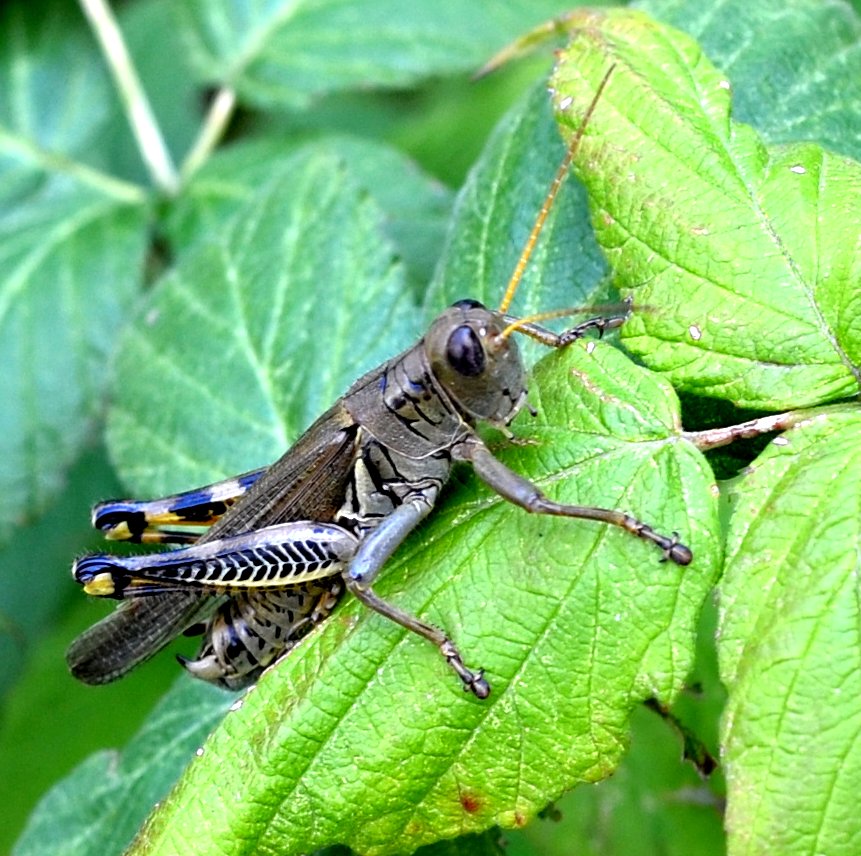
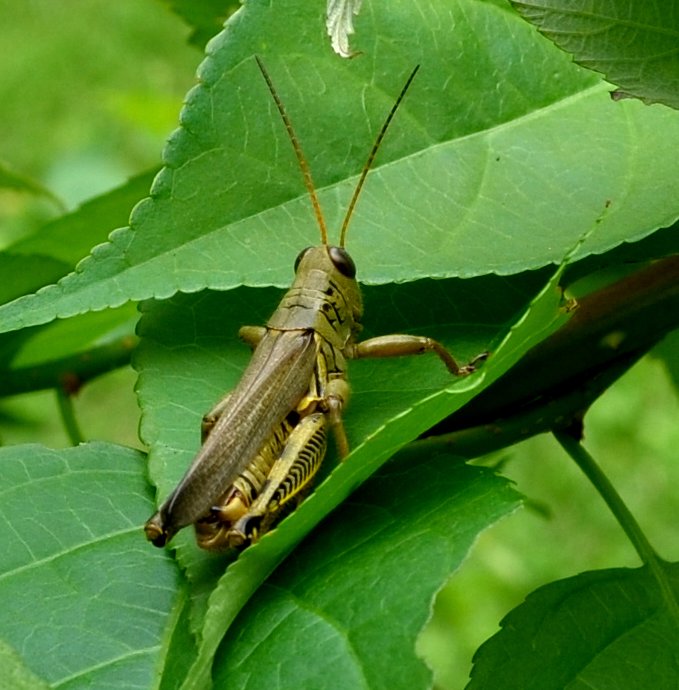
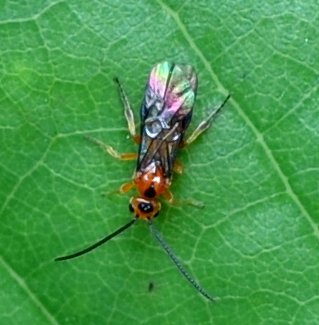
Let's start in on the spiders. Of course the most plentiful were the common house spiders (chs). The females have a variety of patterns but they all at least have the white and black banded legs. The older males are almost solid deep red-orange, and their legs turn this color too.
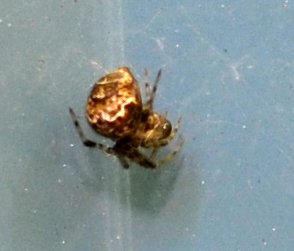
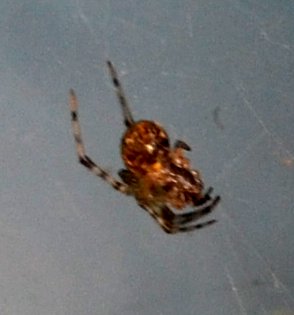
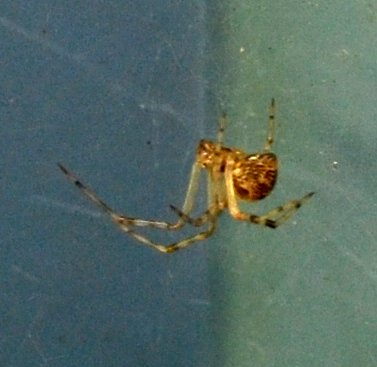
Among spiders, the tiny crab spiders are among the prettiest and also the most common. They also have a variant called a "ground crab spider". The easiest place to find the crab spiders (this one is the Northern Crab)is in the center of an aster blossom and the large crabs frequent the shop walls. The last one is a ghost spider.
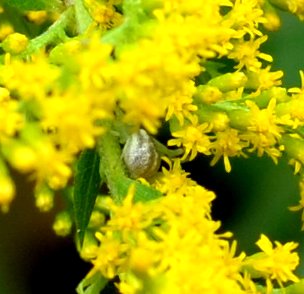
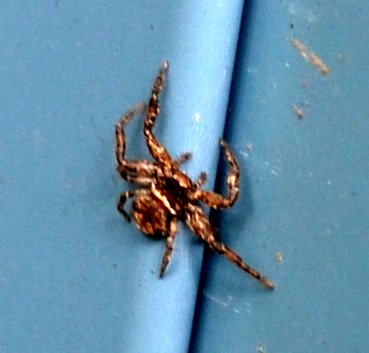
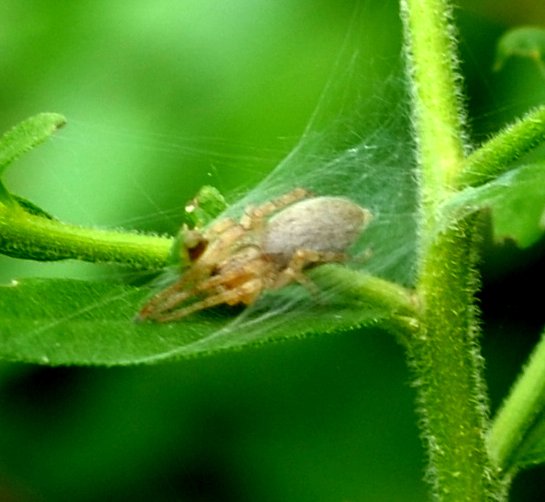
The grass spiders look different shades depending on the light. Here's a "brown-looking" one and a "black-looking" one. And here's a jumping spider. Beautiful patterning! This last one is a new one for me. I think it is called a Broad-faced Sac Spider.
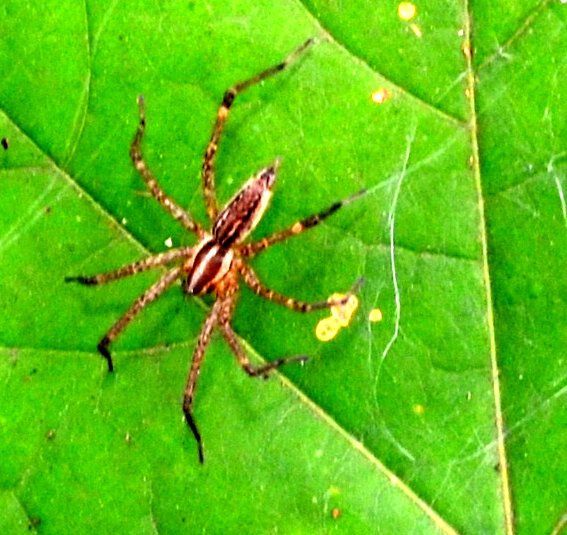
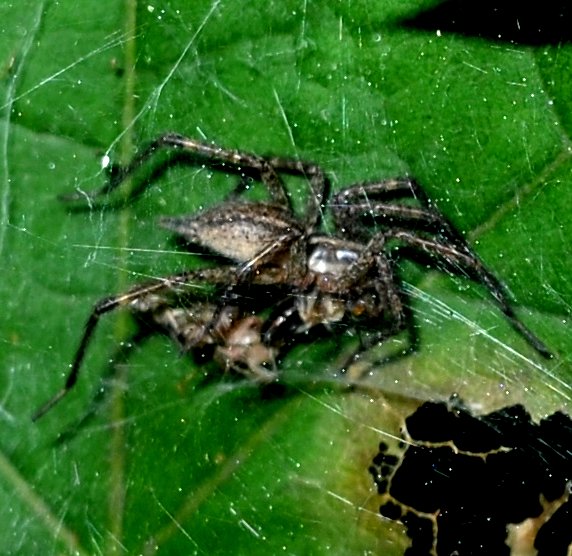
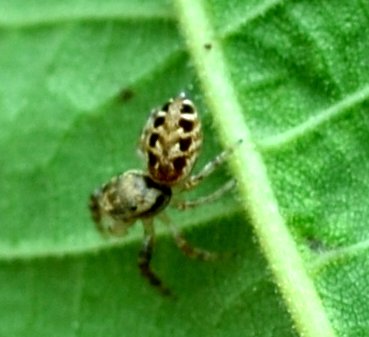
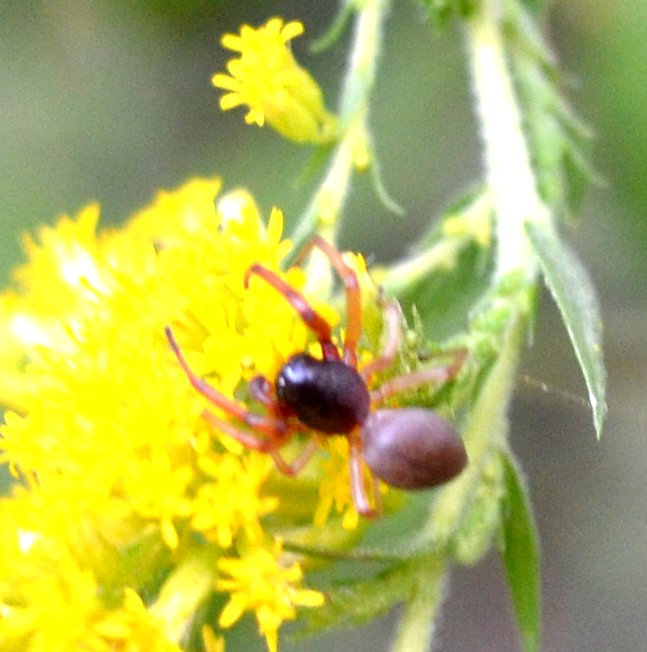
The Ancistrocerus genus of potter wasps has a few varieties with either whole or partial happy-faces. Here's A. adiabatis,with its full happy-face and abdomen with broad band, wide black space and then broad band and three more narrow bands. Then comes A. campestris, with its happy-face, broad band, space, broad band, narrow band and mostly invisible on down. (This is what I've learned from the book by M. Buck et al.) The bee wolf (a wasp that preys on bees, can you imagine?) has a big square head with four commas on the back of its head, a clerical collar on the back of its "neck" and that should do it even if you can't see under the wings. Now that I know where to look they have become much more prevalent around here. Yellow bands that only go to the middle of the back, you can guess it will be a member of the Crabro family, maybe Ectemius maculosis. Macula is a spot (think of "immaculate" - no spots)- maybe this applies to the dimpling of the outside "skin".
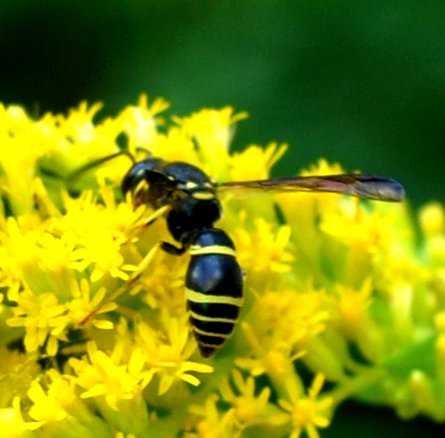
.jpg.)
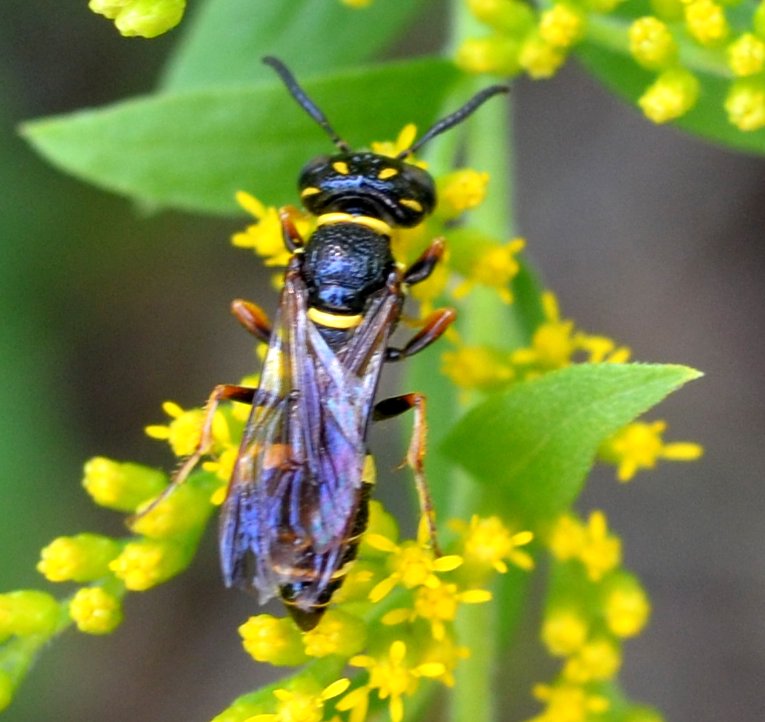
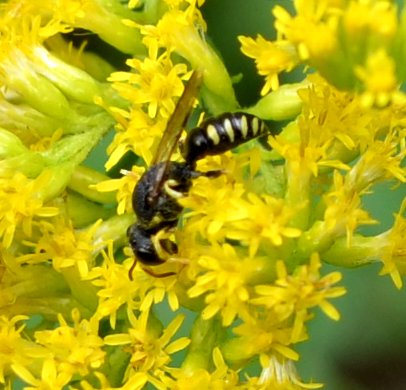
Eumenes fraternus is another of the potters. It has a long waist and remember the "comma-like dot" on what would be on the side of its abdomen up high. Then comes Cerceris arenaria (last two pictures). If you can get it to face you it has a distinctive two parallel yellow lines on its face (with a dot in between.)
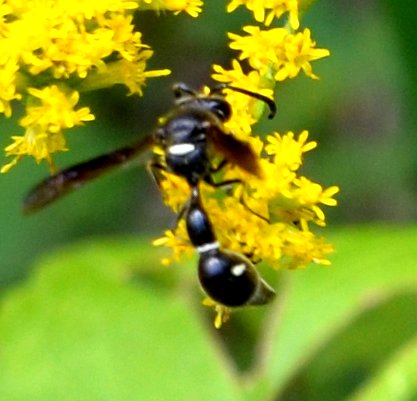
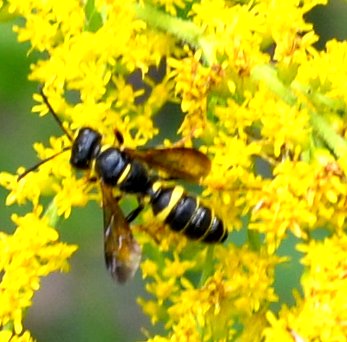
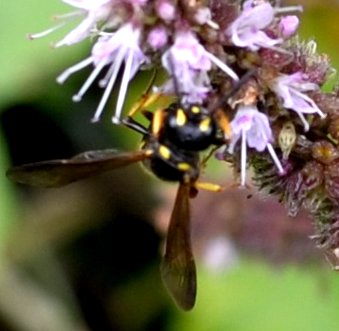
There are two genera of yellow-jacket, Dolichovespula (long little wasp) and Vespula (little wasp). (Dolichovespula also includes the bald-faced hornet.) We only see a few of the Vespula, and so far I've only seen V.vidua. The worker (female) looks like this on the abdomen, and this on the face. Third is the face of a male D. arenaria (aerial yellowjacket). I think this is probably overwhelming. There are lots of patterns I don't know yet. I have to go and look in Buck each time I see another.
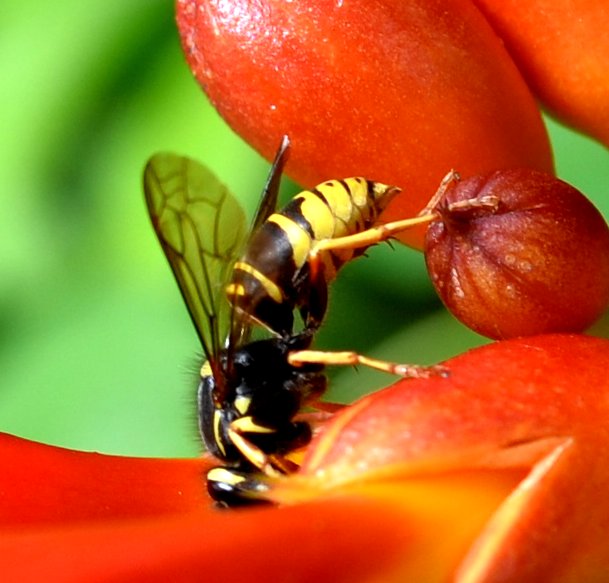
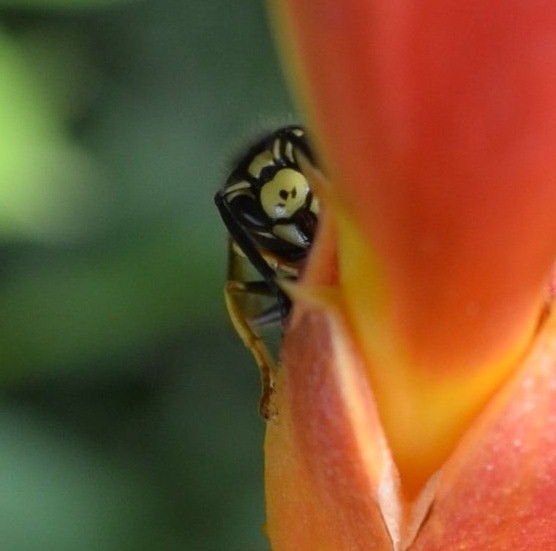
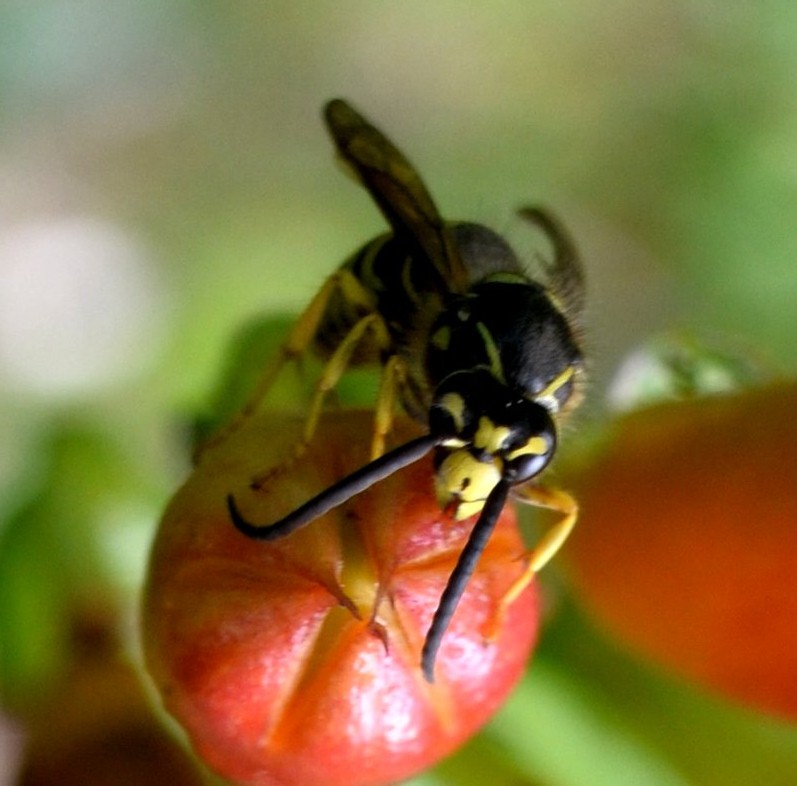
This image of the potter wasp Eumenes fraternus managed to catch its face and also its stray comma mark on the upper part of the abdomen Now Vespula is a genus of yellowjackets. This week Vespula vidua, the Widow Yellowjacket, was quite prevalent out there. This one has caught a large bit of prey to take to feed its babies. This Dolichovespula (name means "long yellowjacket") arenaria (means has an arial nest) male is, surprise, an arial yellowjacket and very common at that wasp eatery, the Trough of Trumpetvine.


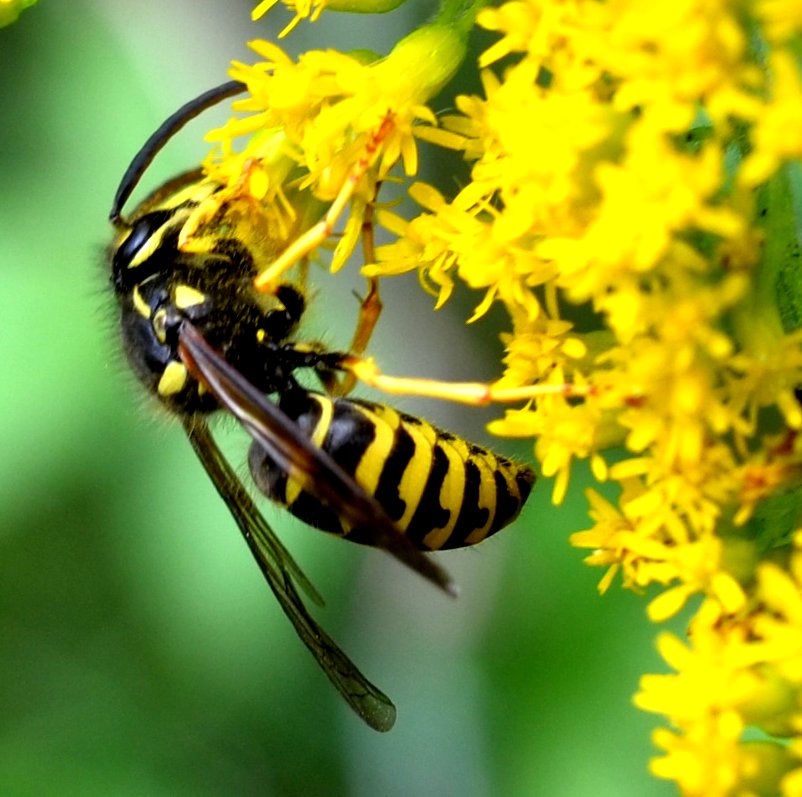
The ichneumon wasps love to frolic on the hosta leaves. Here's one that we saw last week, a male ichneumon, Setanta compta.
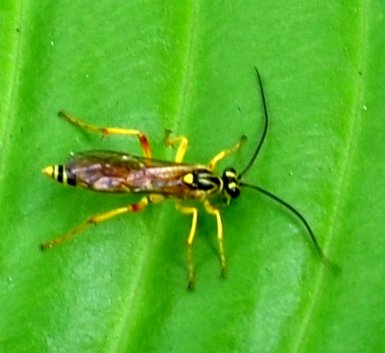
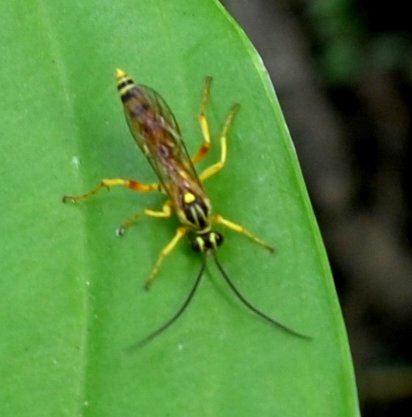
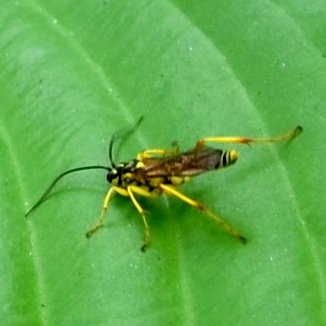
There are still a lot of European Paper Wasps. First here is a male. But the activity level seemed down a bit back at the AC Hotel.
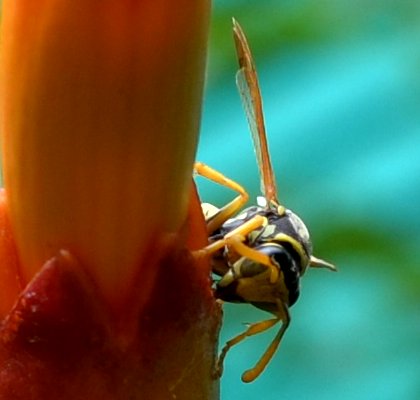
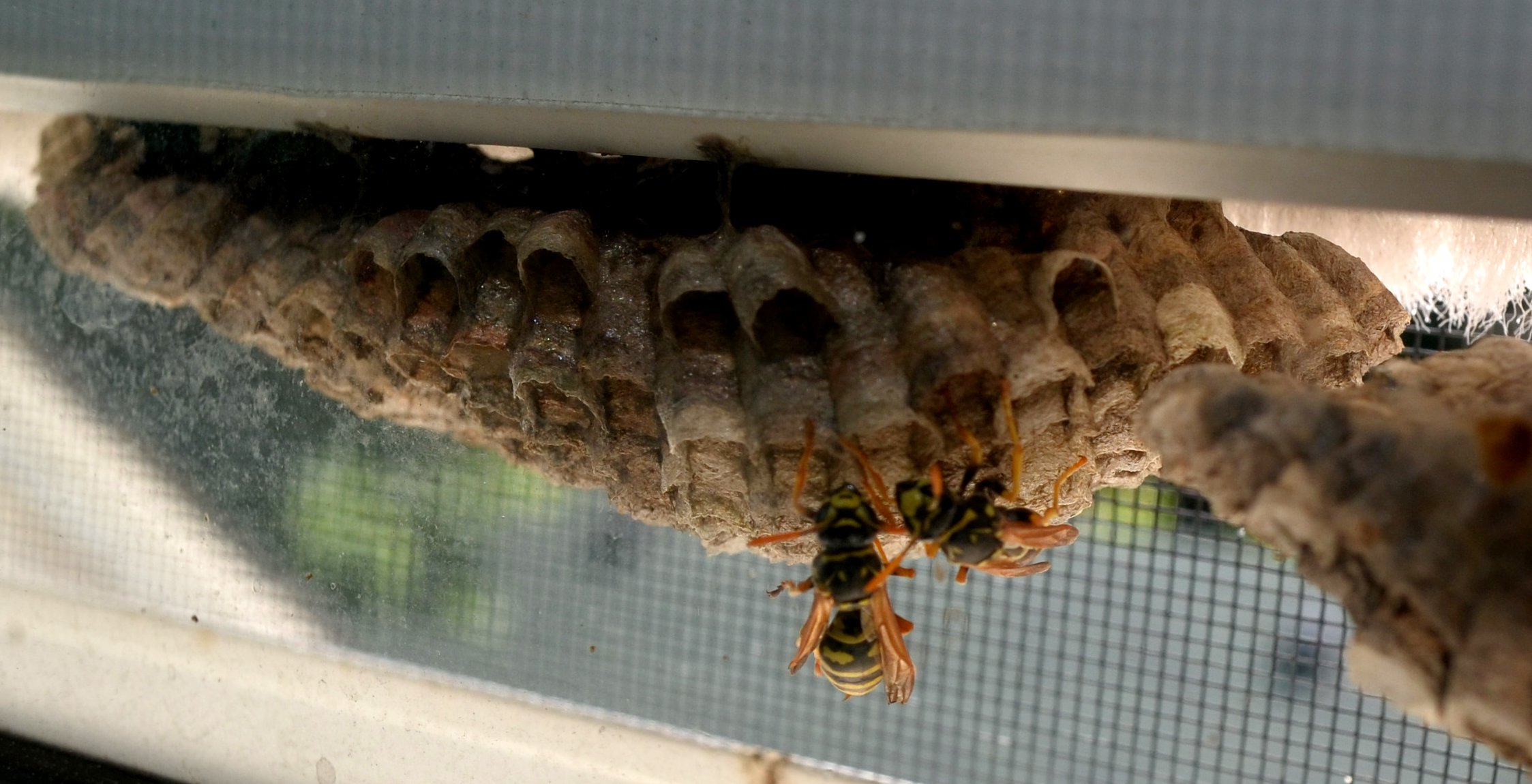
A couple more pictures to round out the blog. This is a phlox I actually bought years ago. It isn't so happy shade-wise but its flowers are a gorgeous shade of hottest pink. And a story that needs no words. Not many raspberries this late in August!
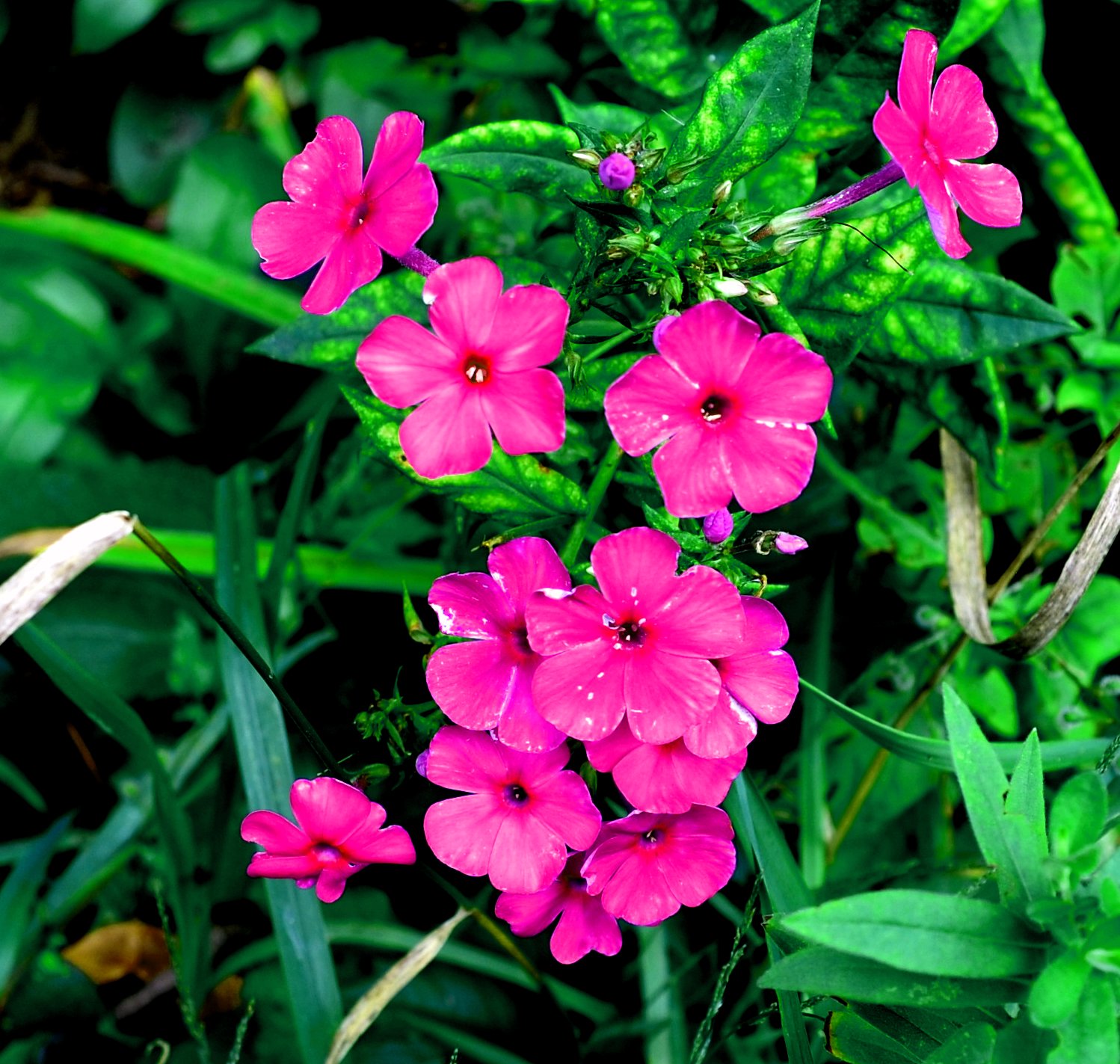
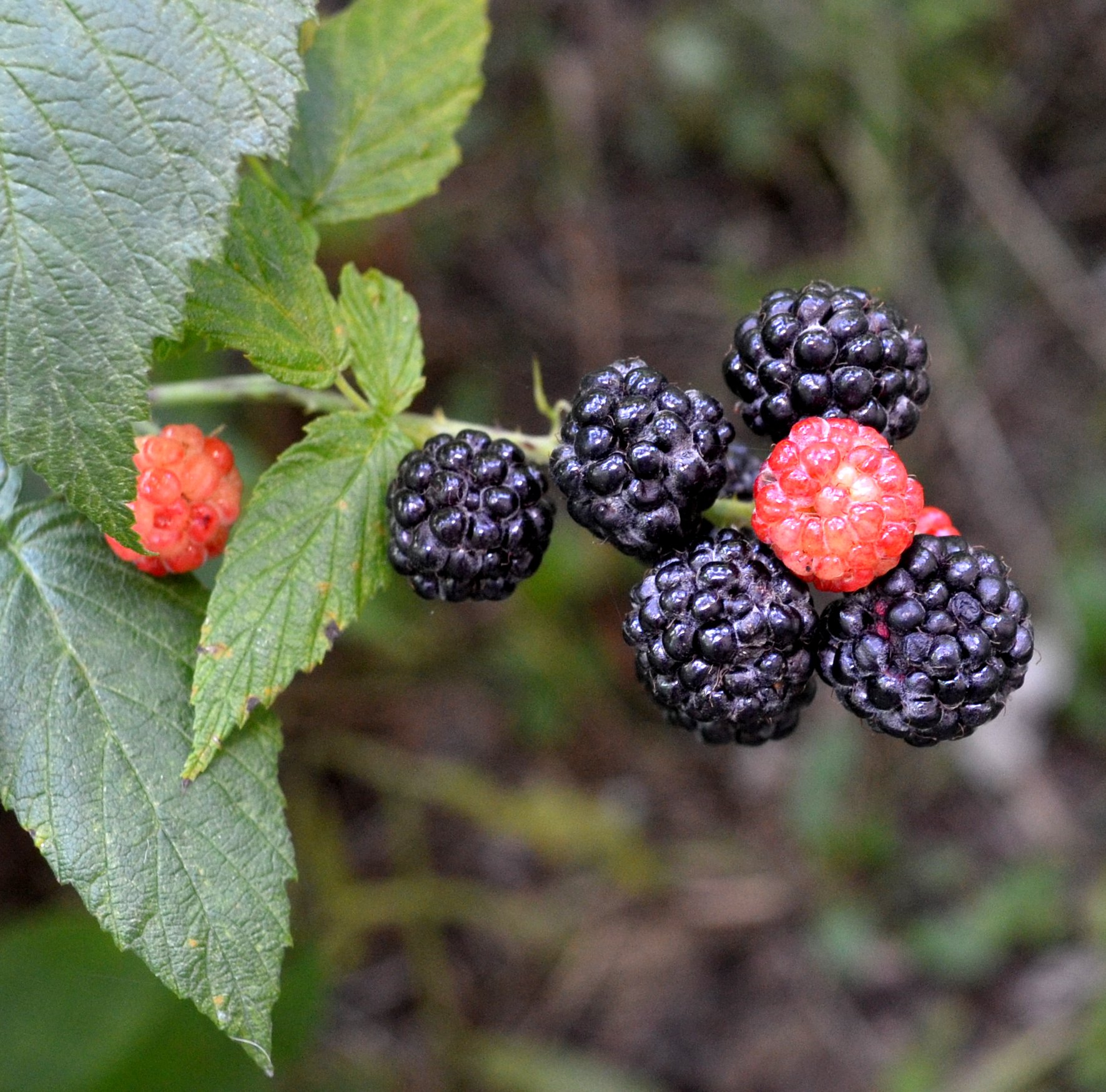
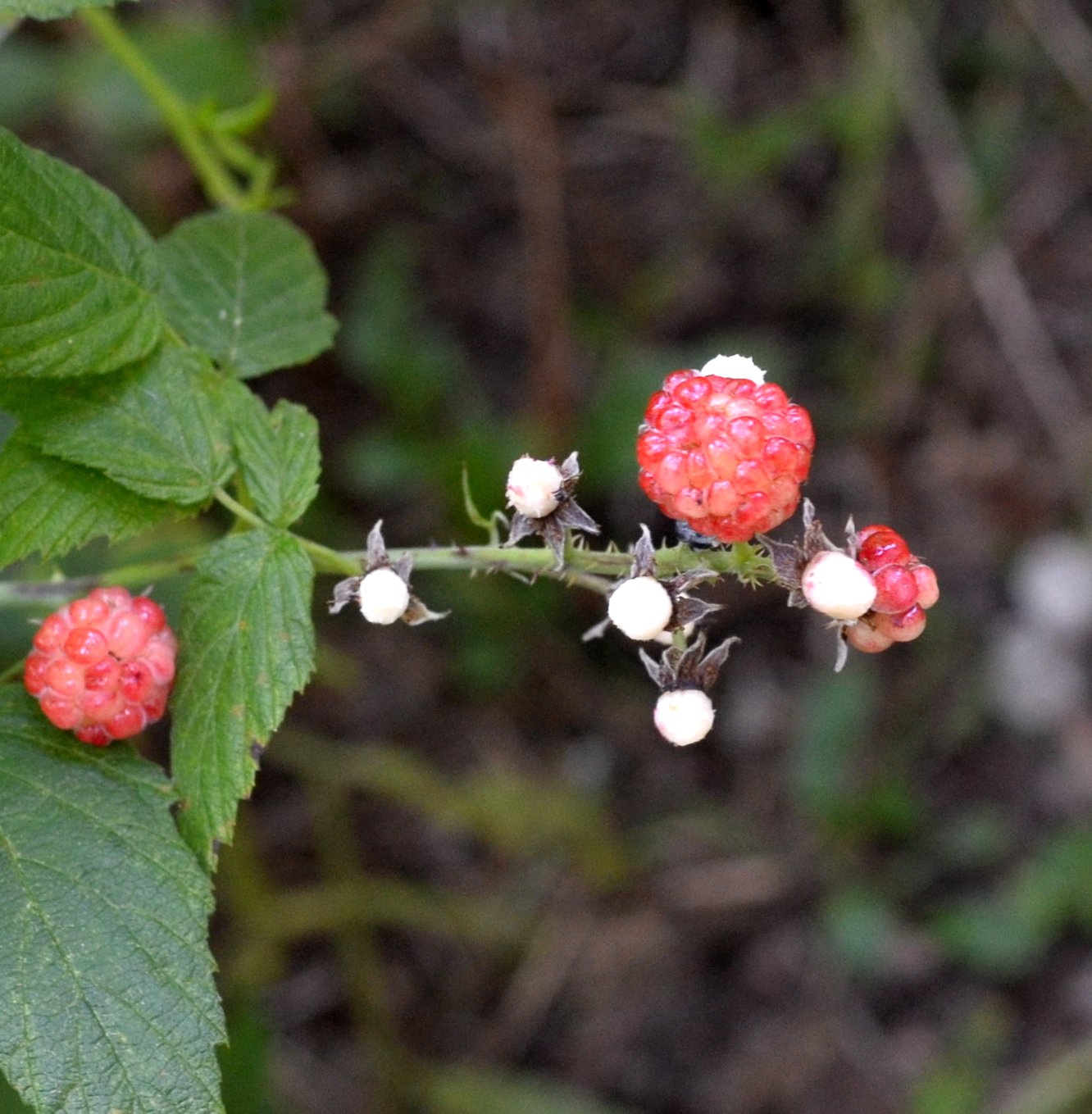
That's about the news from the garden that transforms itself every season into a haven for another kind of little creature! I hope all is well with all of you.
Love, Martha
Back to August 28
On to September 11
Back to 2016 menu
Back to main menu
copyright Martha O'Kennon 2016


















































































.jpg.)


















